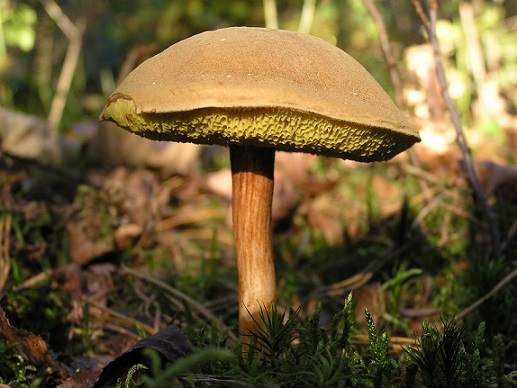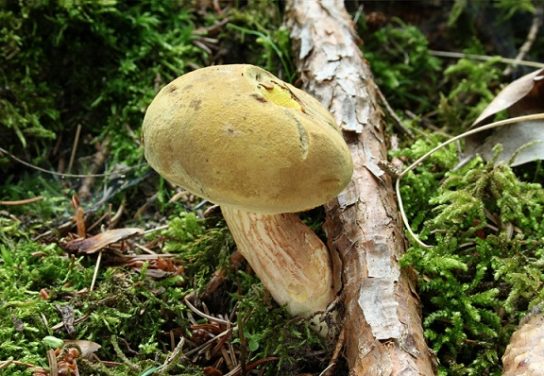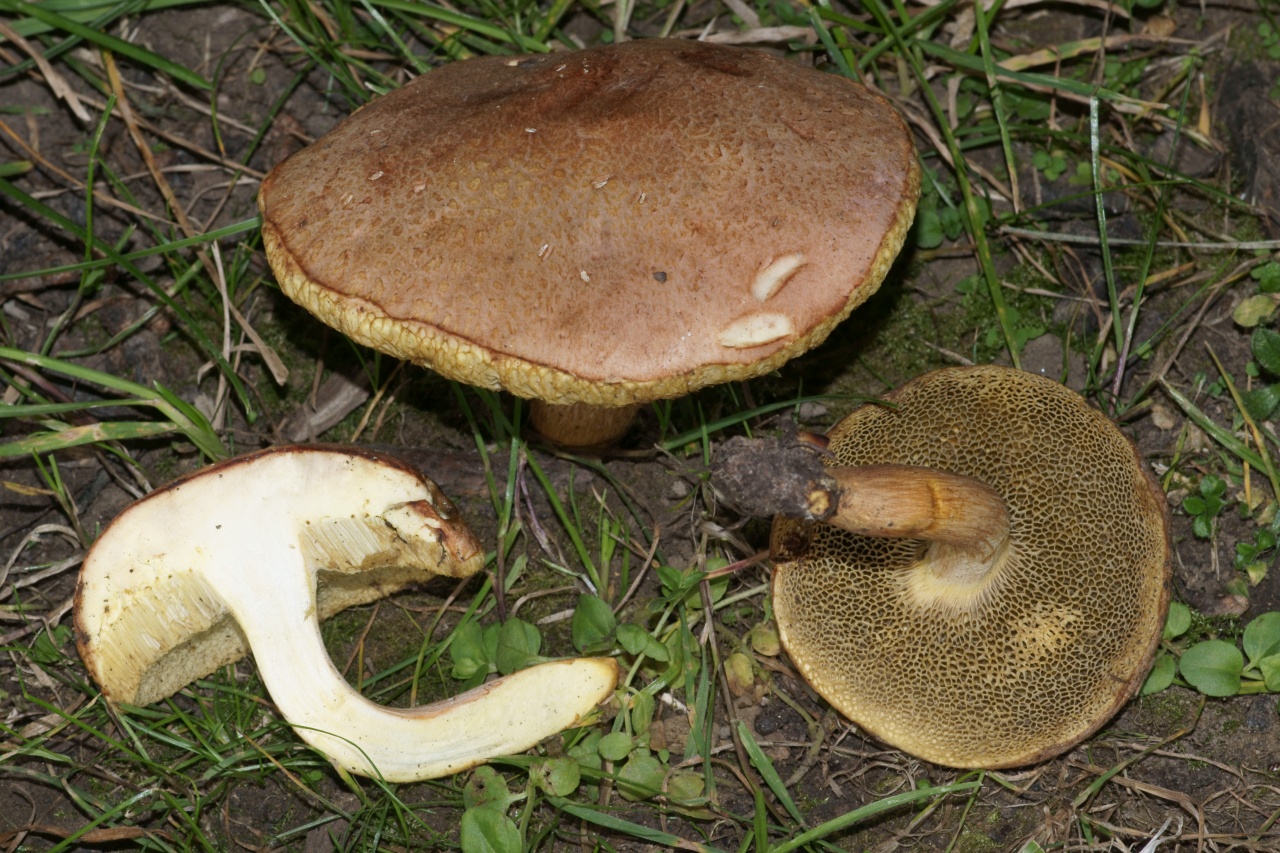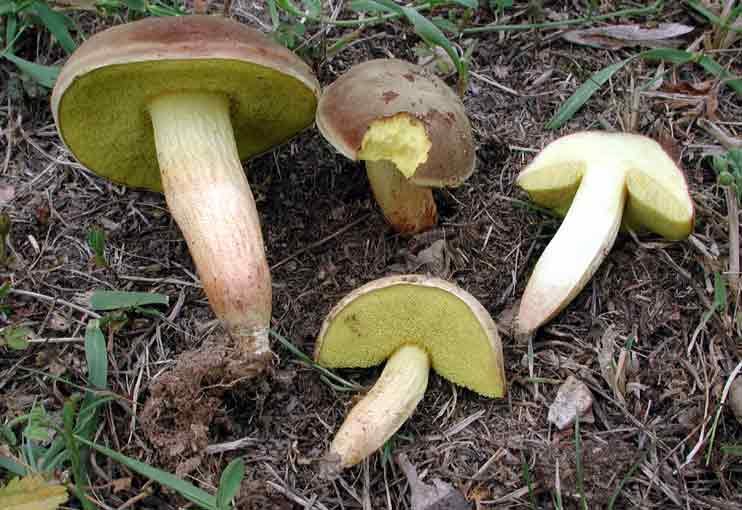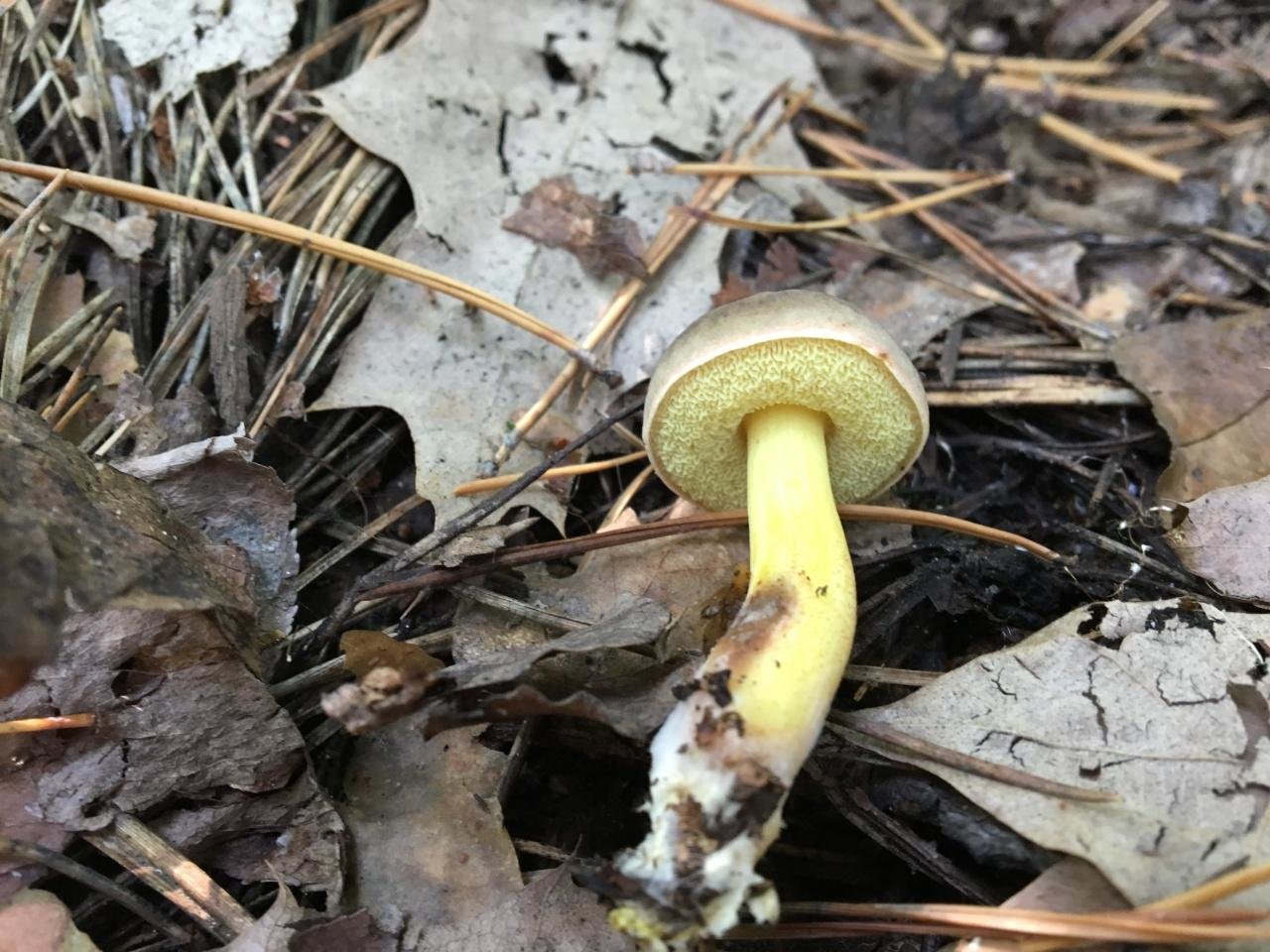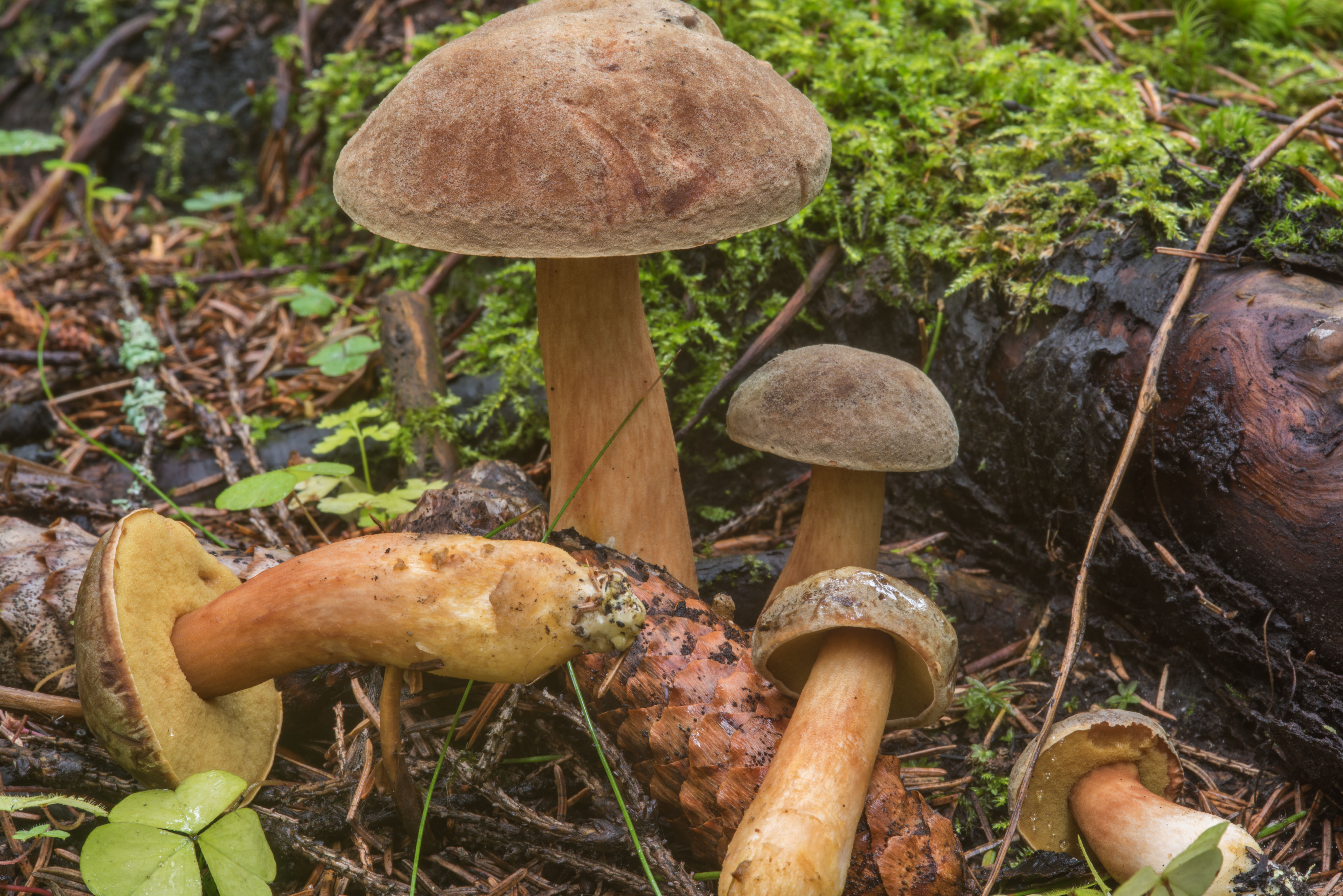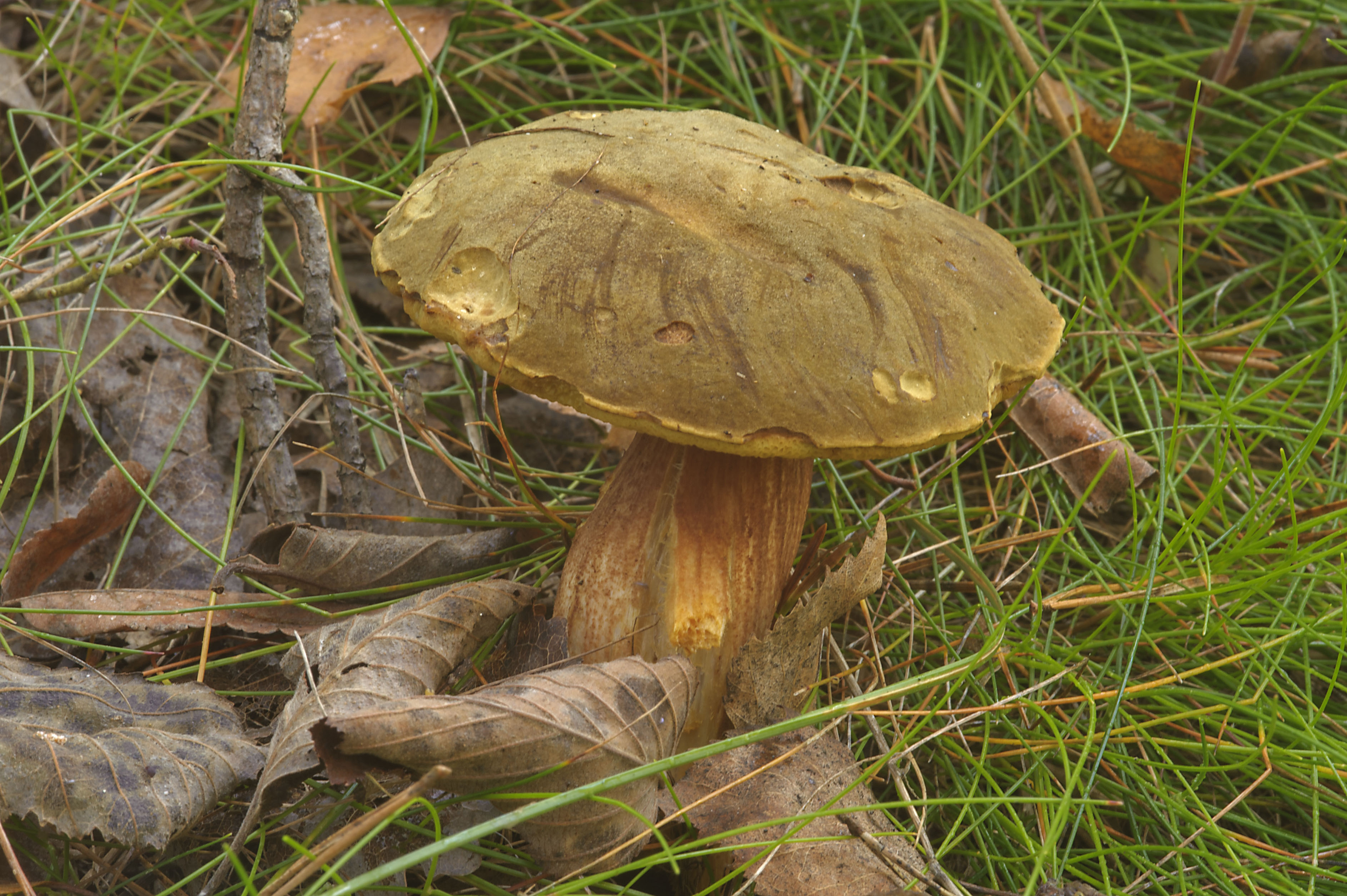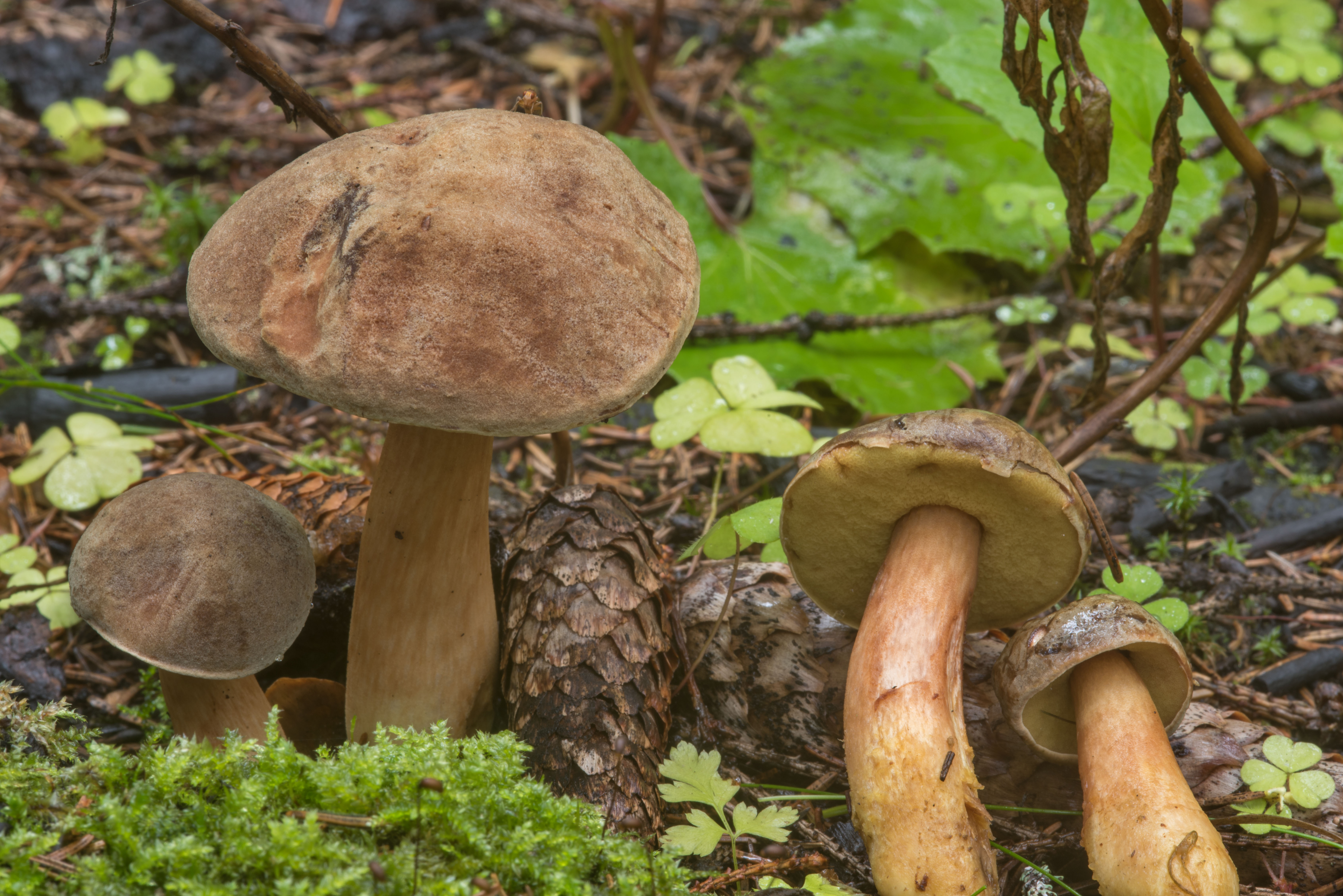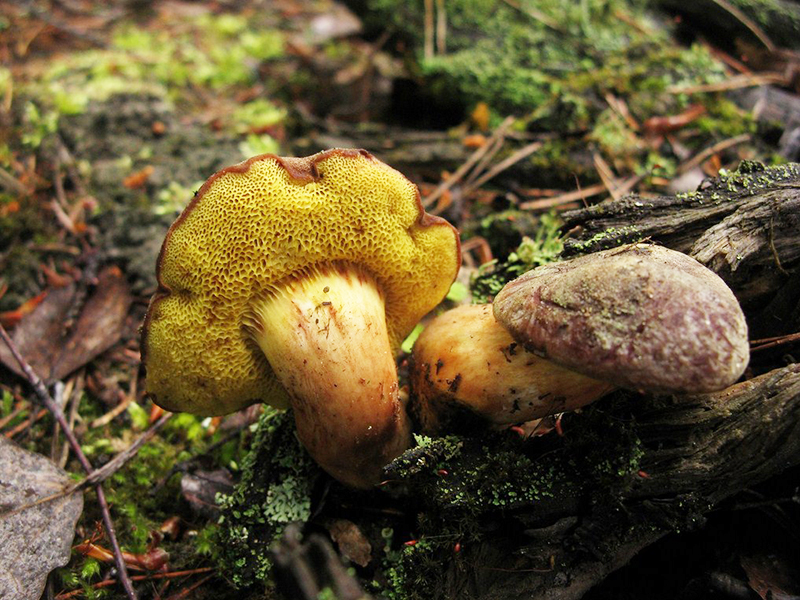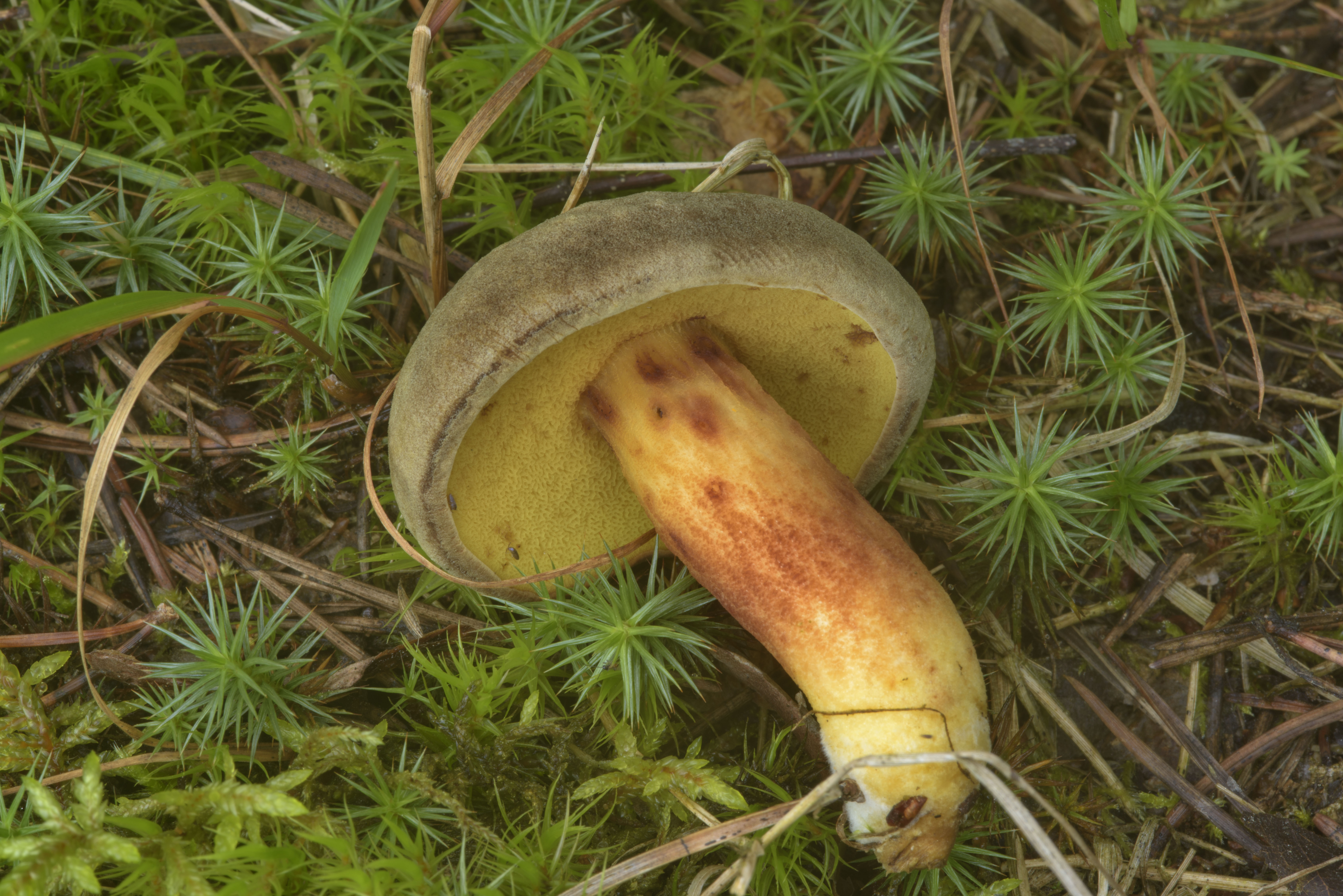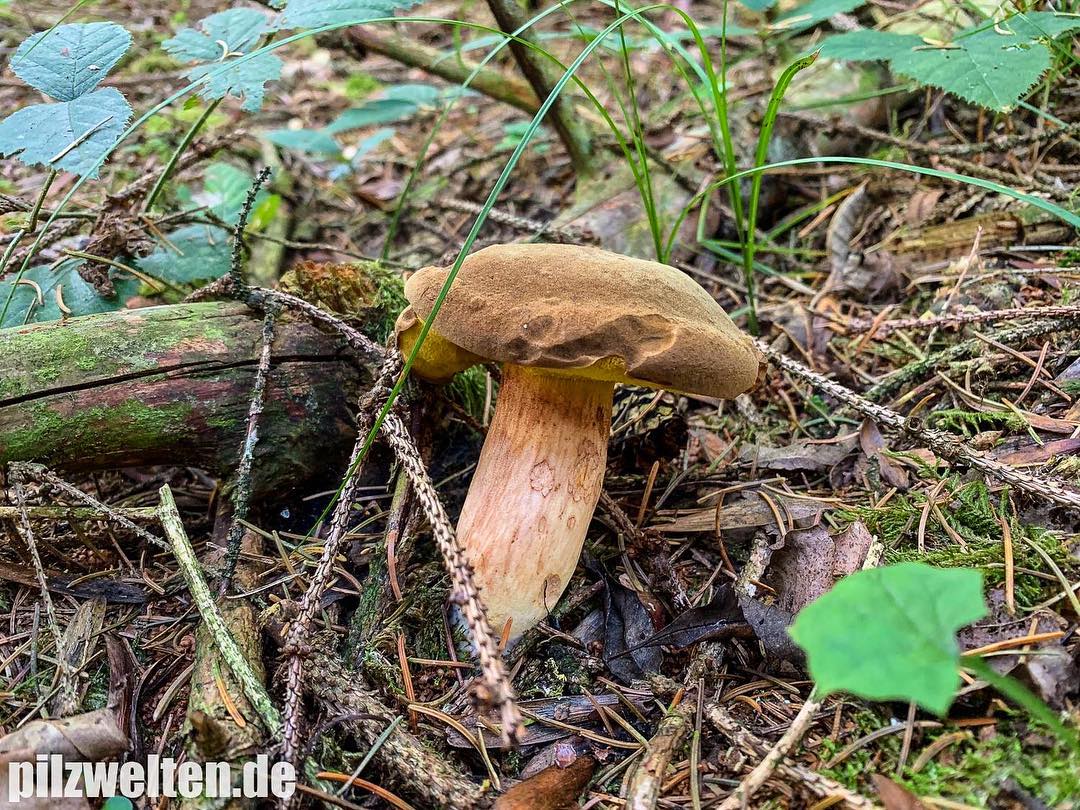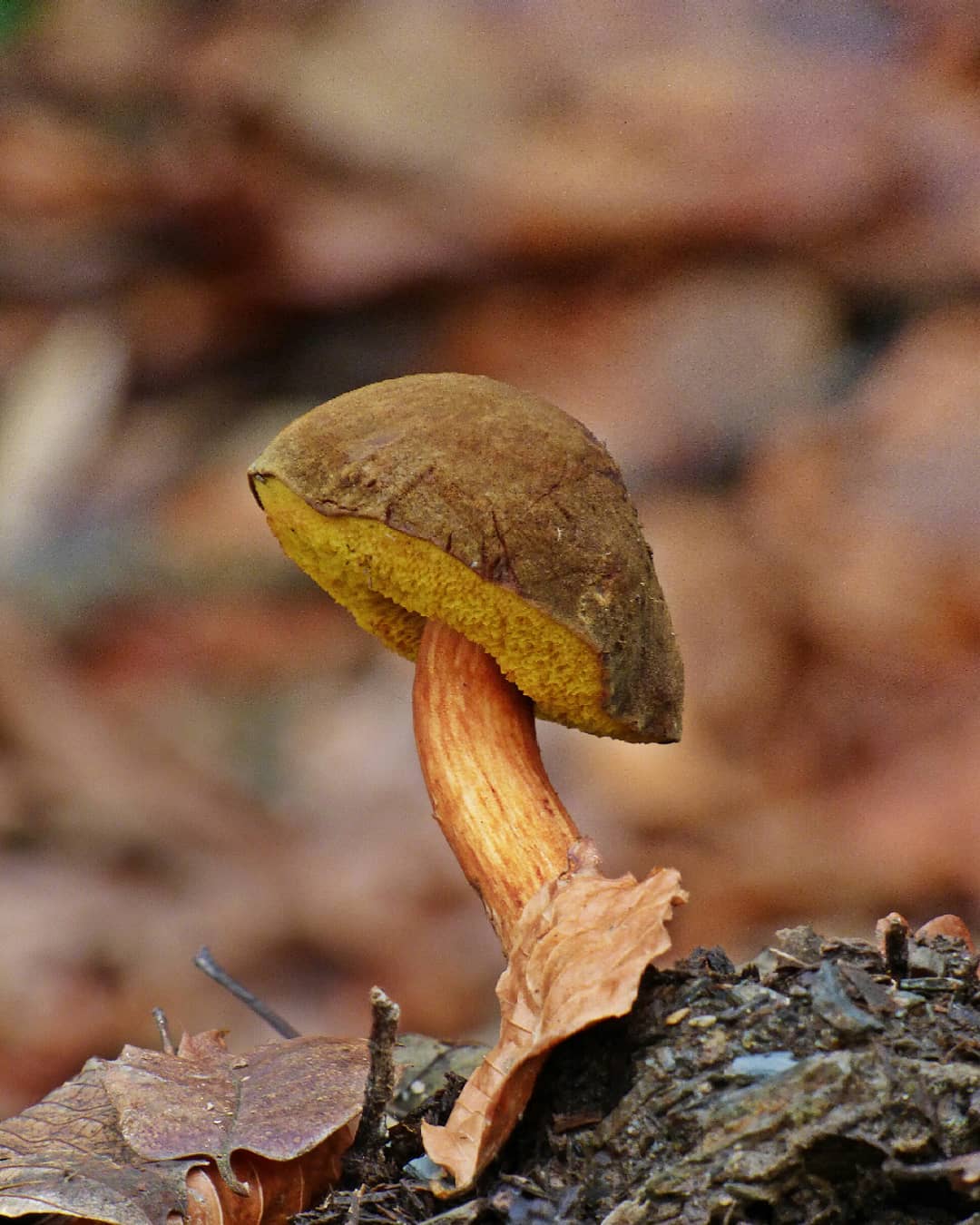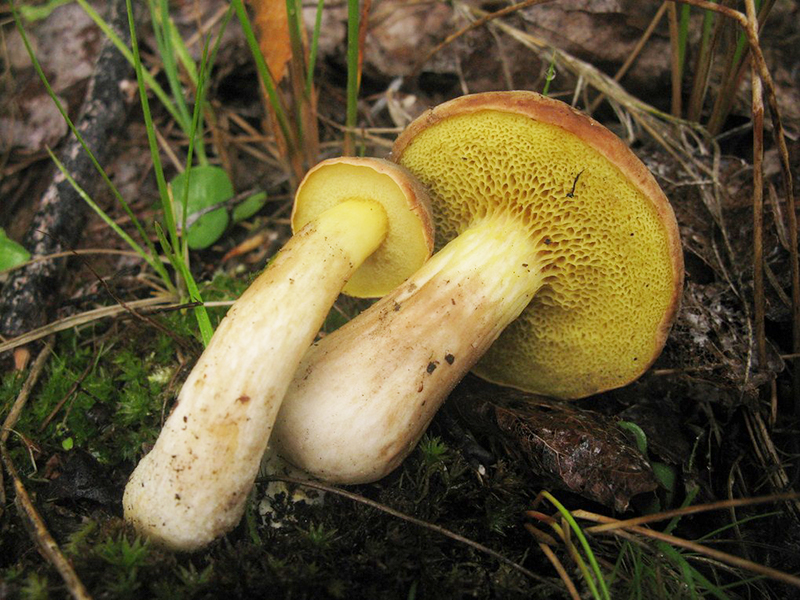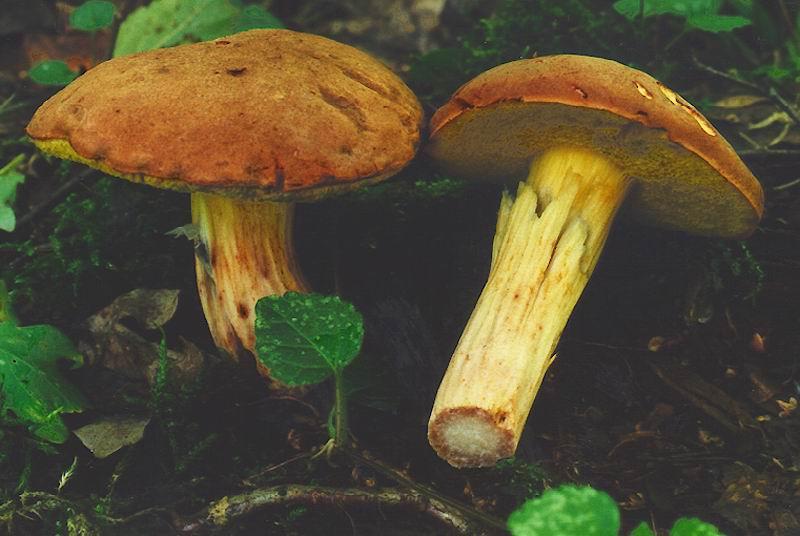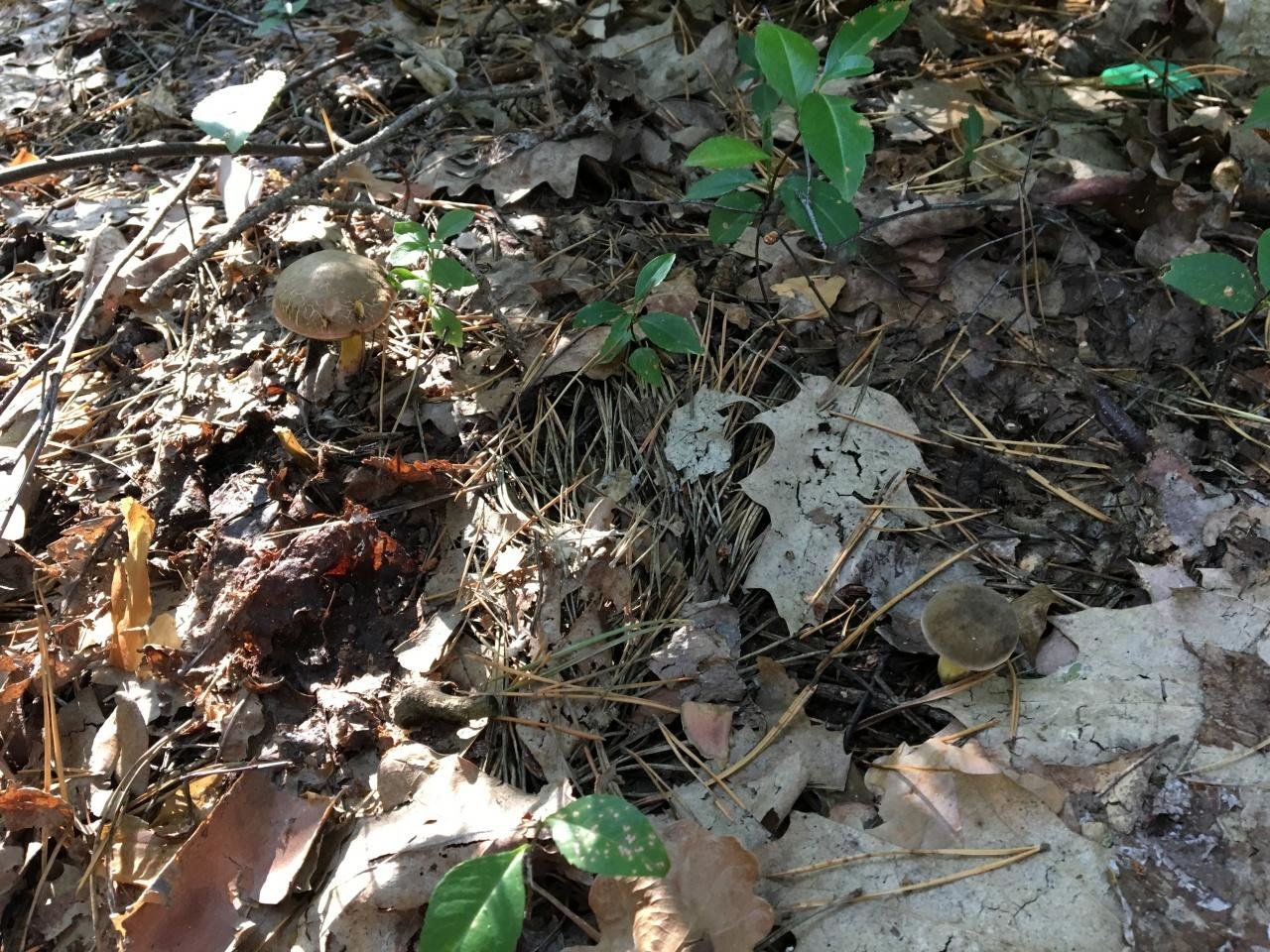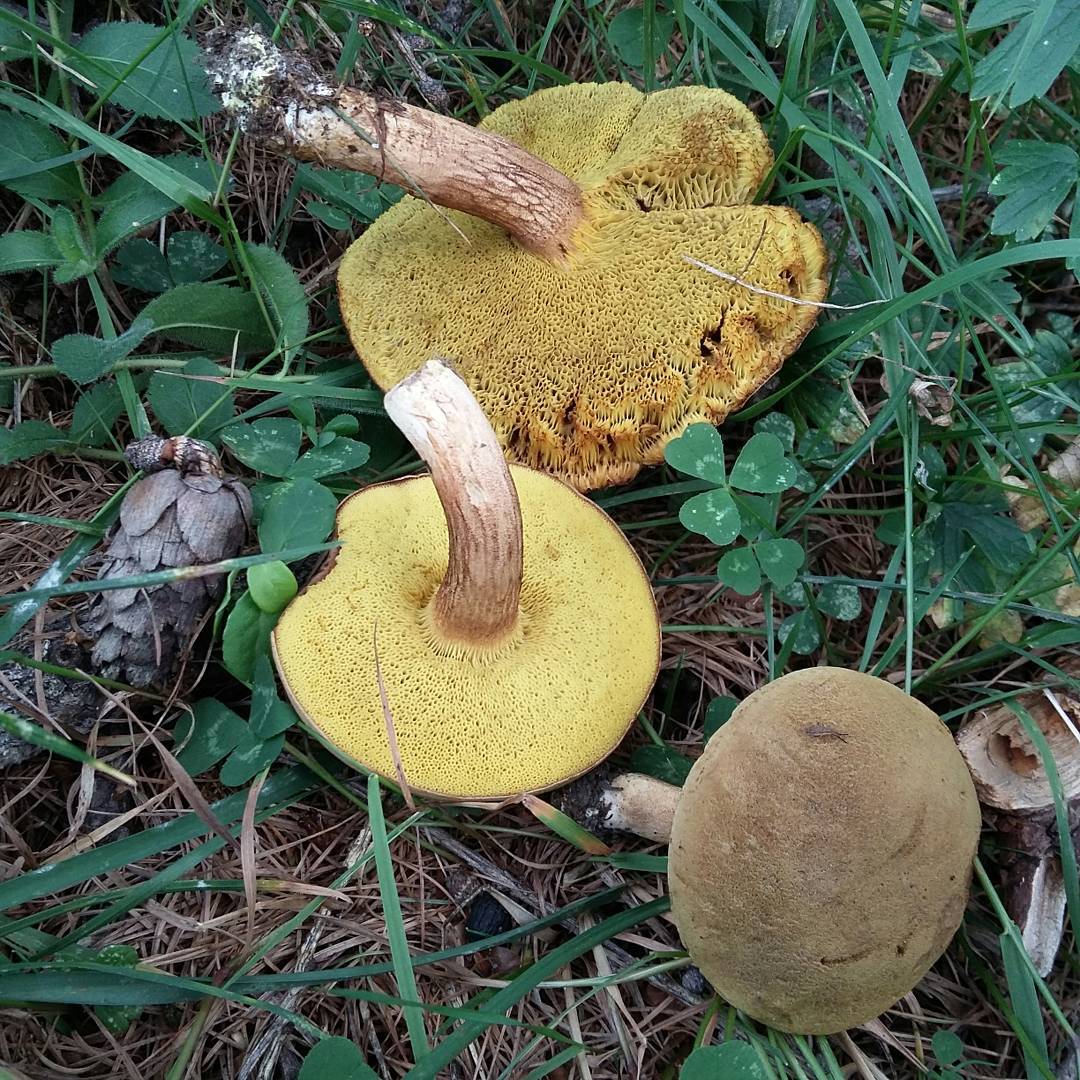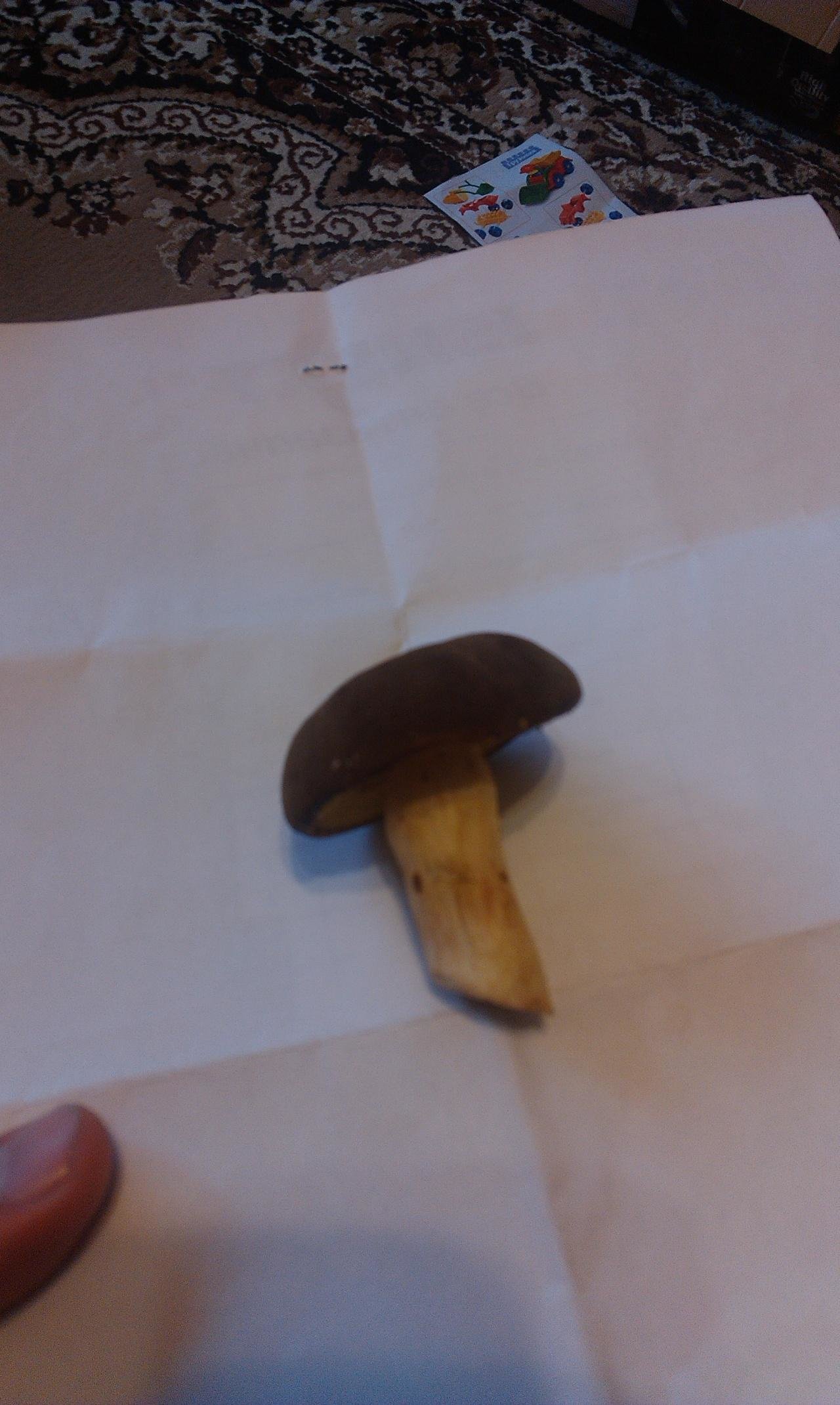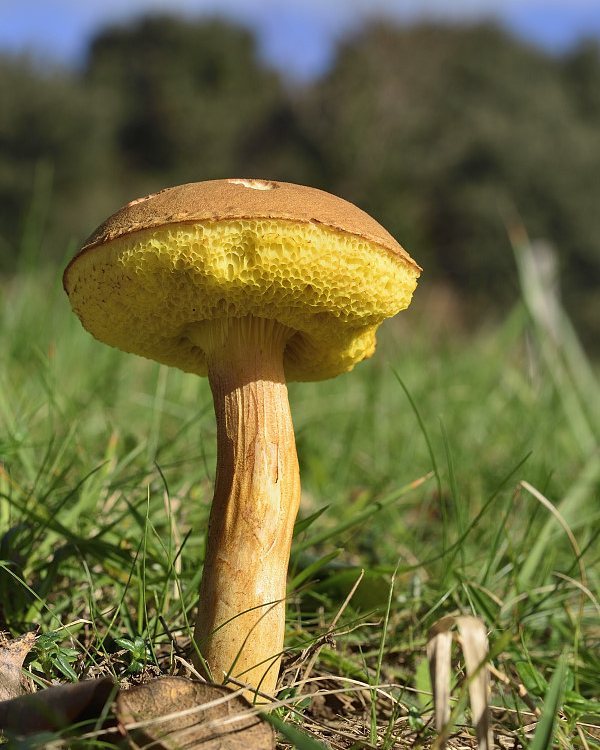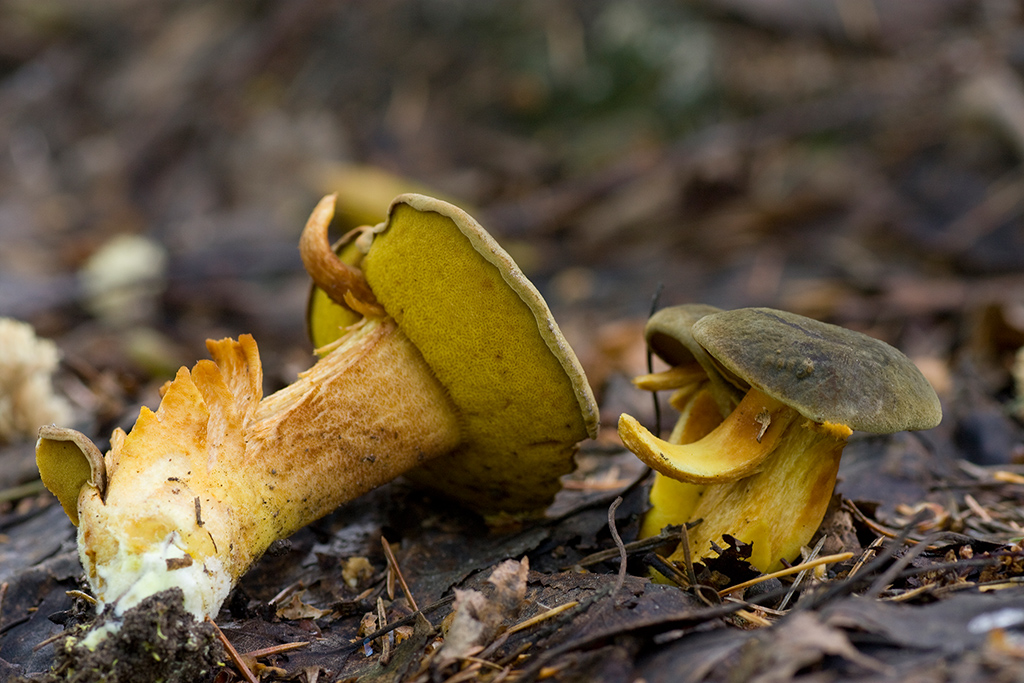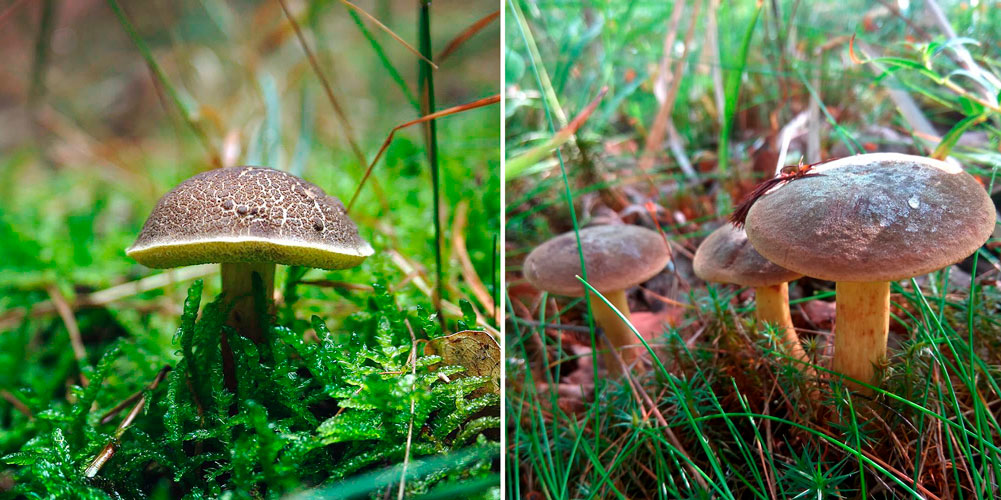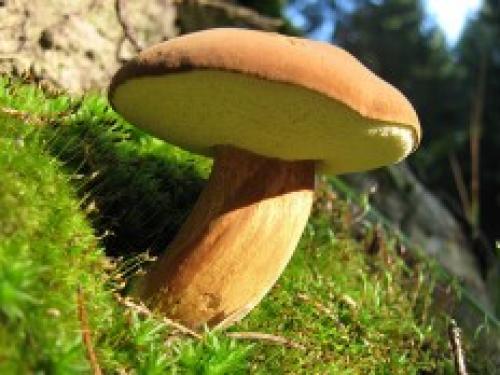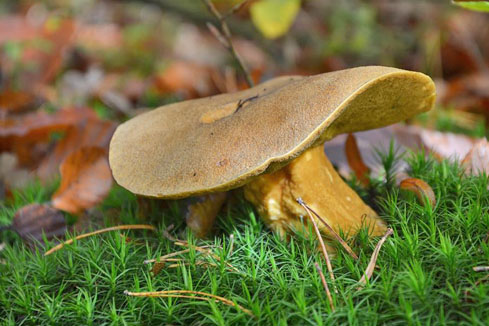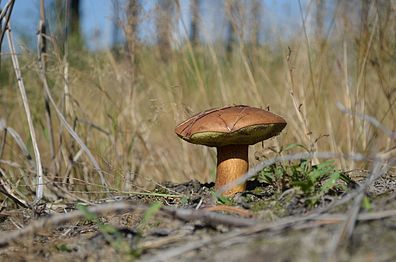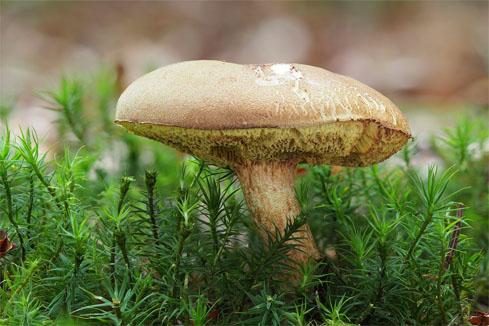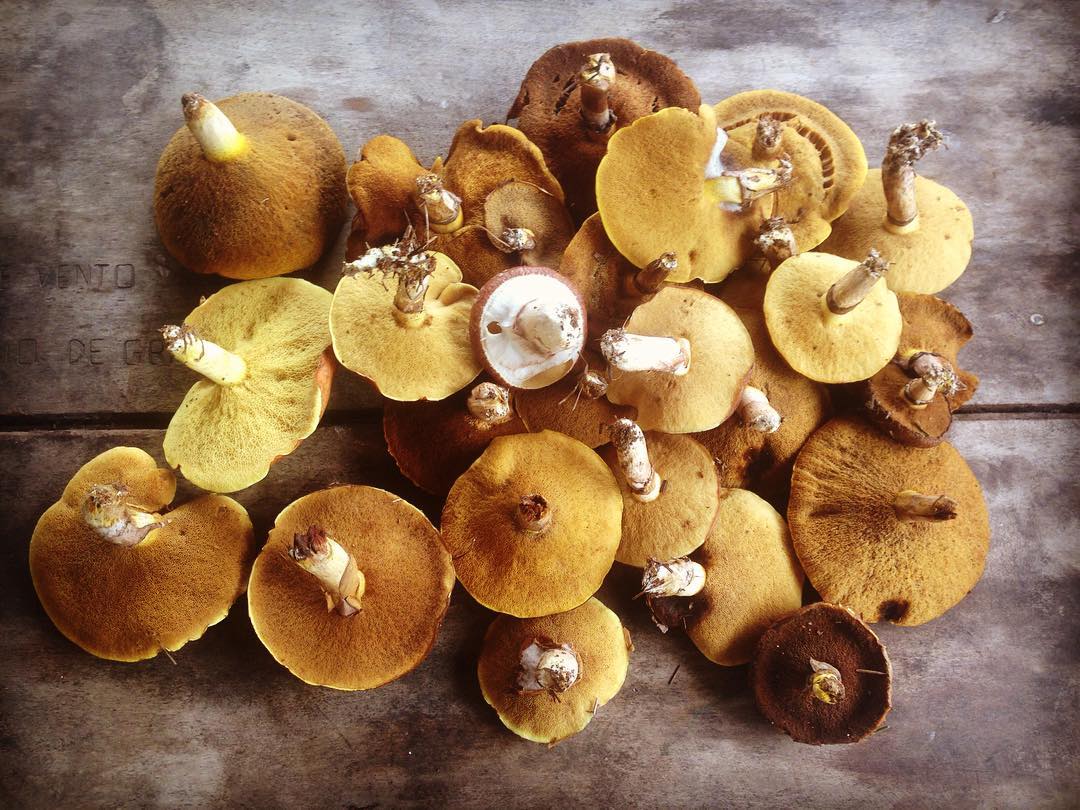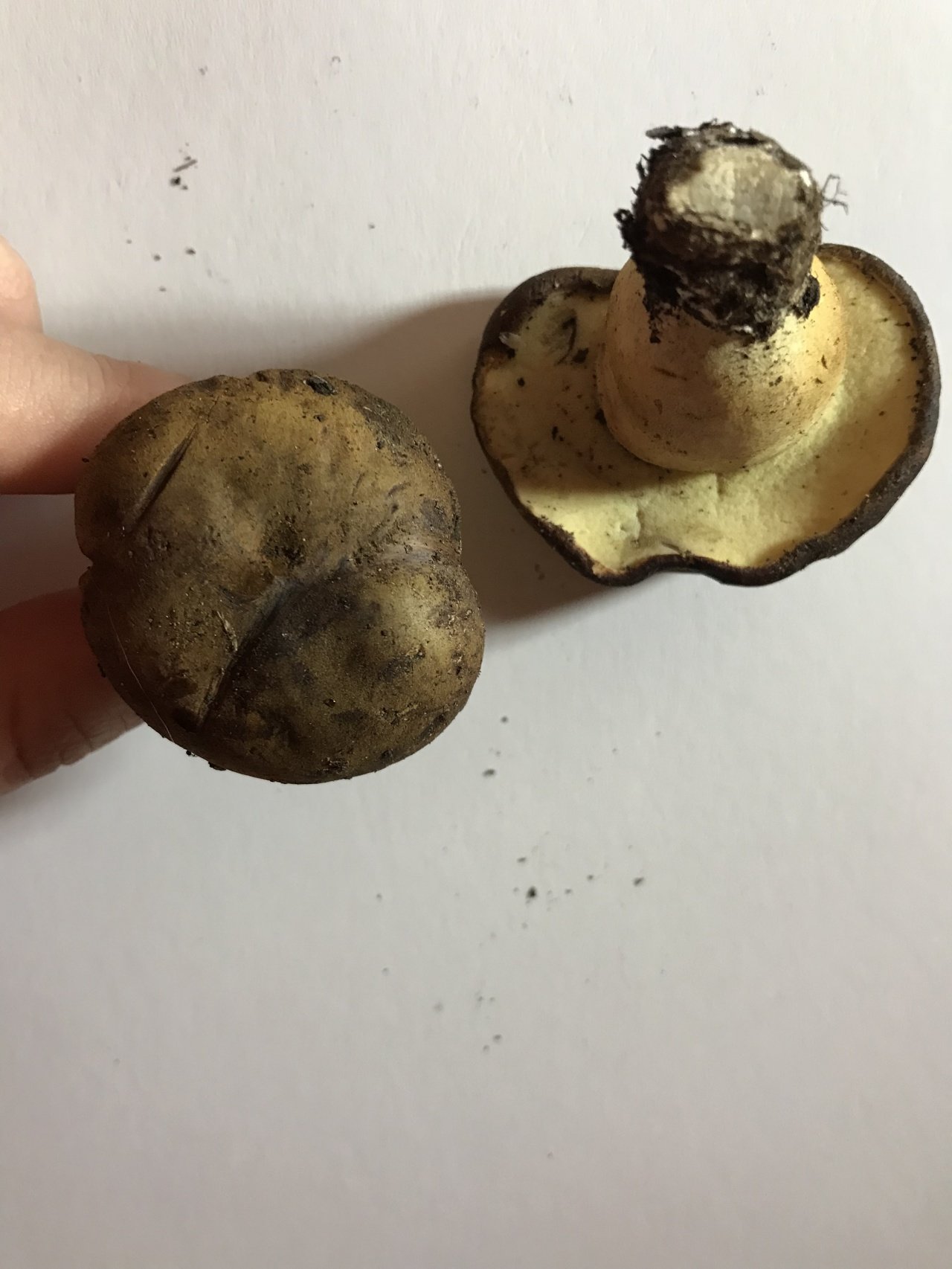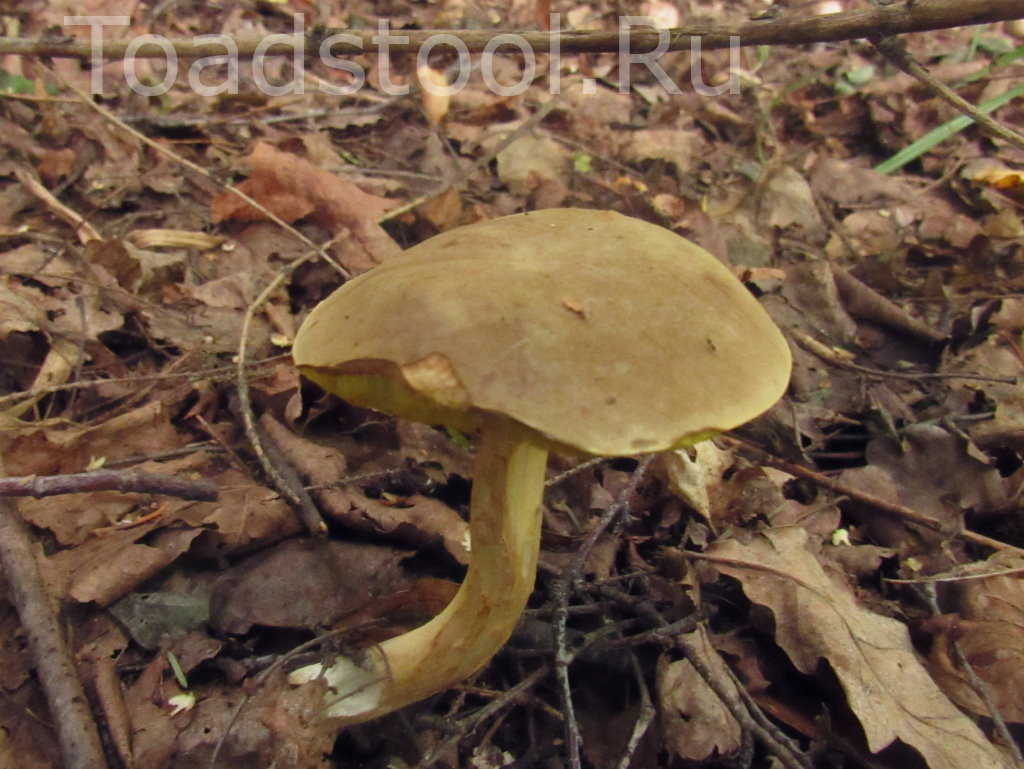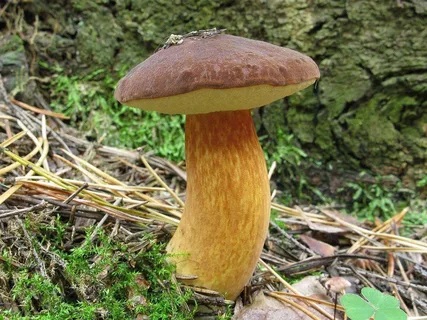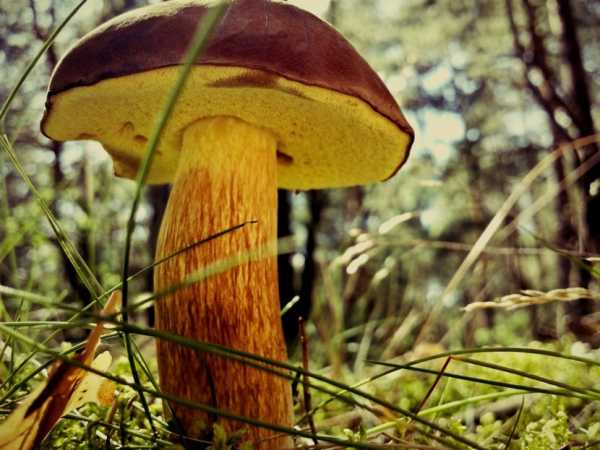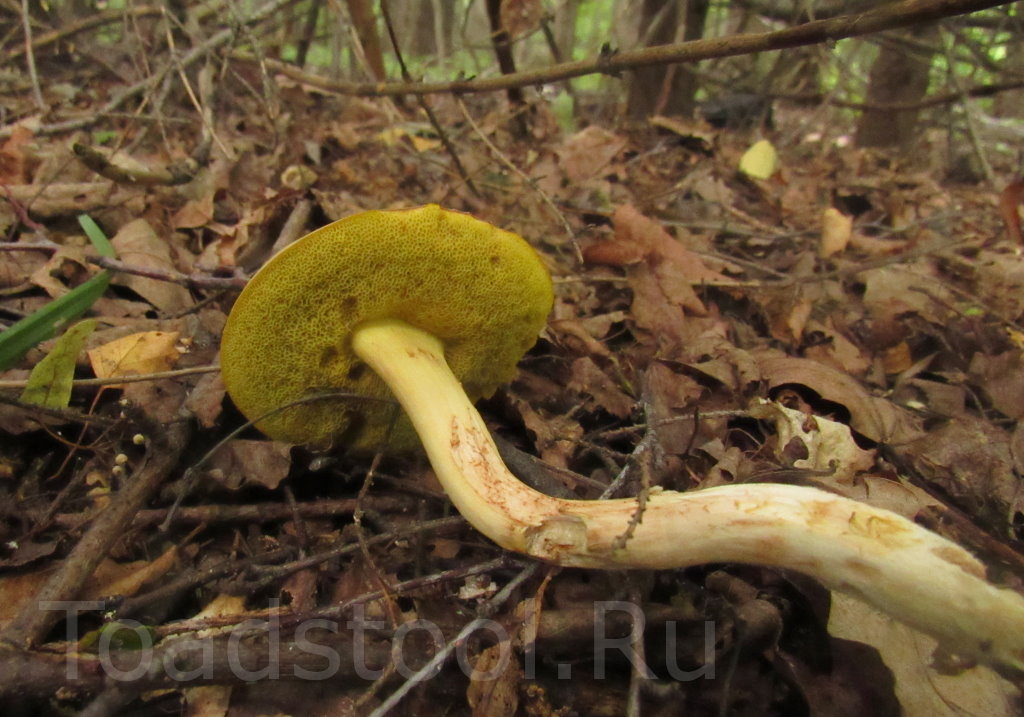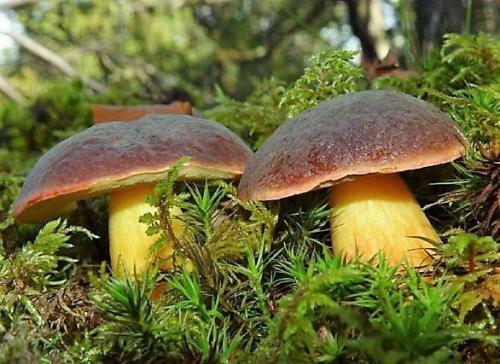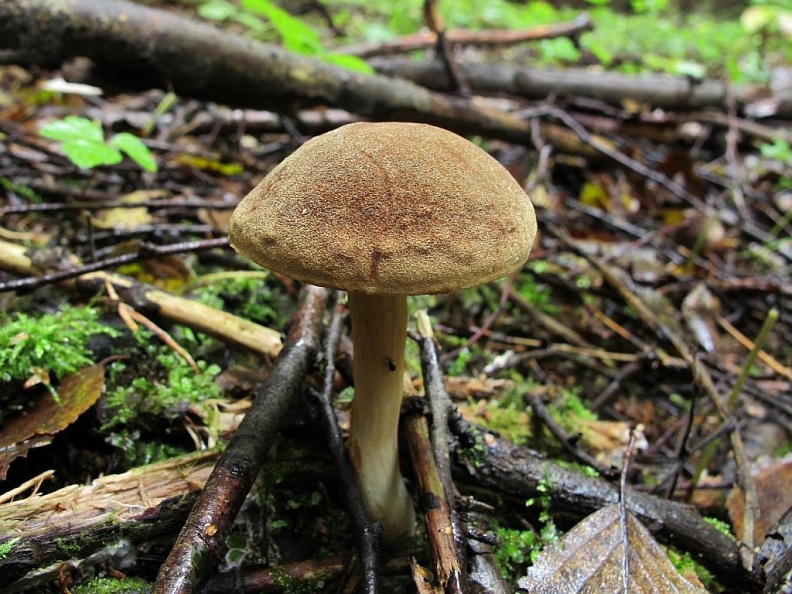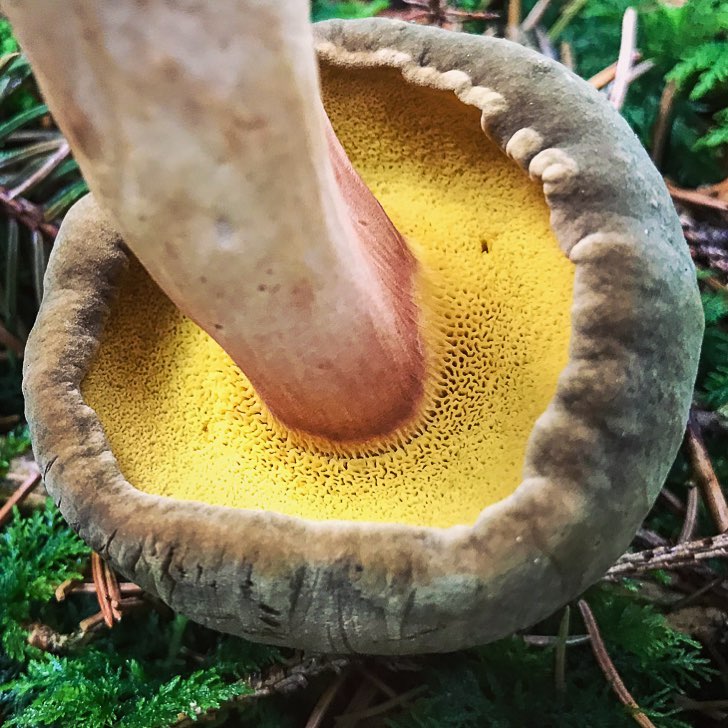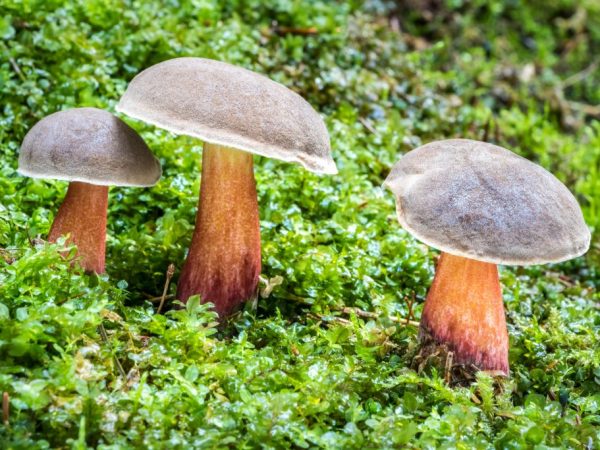Motley (fissured) and velvet flywheels
The variegated flywheel, or fissured flywheel, is an edible tubular mushroom that grows singly or in small groups from early July to early October. The largest harvest is in August. Found in mixed, deciduous, sometimes coniferous forests.
A mushroom cap with a diameter of about 8-10 cm. The surface is dry, matte, small cracks form an openwork pattern on it. It is colored red or brown with a burgundy or olive tint, with a darker and more saturated color in the middle. In this species of flyworms, the tubular layer is large-pored, adherent, greenish-yellow in color. The stem is rounded, thinner at the base, straight or curved, solid inside, about 5–7 cm high and about 1 cm in diameter. Its surface is flat, dry, dull, yellowish-red.
The flesh in the cap is first fleshy, soft, then loose, stiff in the stem, fibrous, with a pleasant mushroom aroma and taste. Upon contact with air, its yellowish color quickly changes to blue.
The variegated flywheel belongs to the third category of mushrooms. Only the caps of young mushrooms are used for food, which are universal in their culinary qualities and are suitable for preparing a variety of dishes and snacks.
Velvet moss (Boletus prunatus) has a hemispherical cap with a diameter of 4-12 cm, sometimes up to 15 cm. A distinctive feature of the species is a dry matte, velvety-brown cap with lighter edges. The skin on the cap is dry, fine-grained and almost felt, becomes smoother over time, a little slippery after rain.
The leg is cylindrical, 410 cm high, 6-20 mm thick. The stem is usually lighter in color than the cap, often curved, creamy yellow and reddish in color.
Pay attention to the photo - this edible flywheel has a dense, whitish flesh with a yellowish tinge, when pressed slightly turns blue, has a weak mushroom taste and smell:
The tubules in youth are creamy yellowish, later yellow-green. Spores are yellowish.
Variability: The cap becomes dry and velvety over time, and the cap color changes from brown to reddish brown to brownish brown. The color of the stem varies from light brown and yellow-brown to reddish-brown.
There are no poisonous counterparts. According to the description, this mushroom is a flywheel similar to a variegated flywheel. The main difference is that Boletus chtysenteron has cracks on the cap.
Habitat: grows in deciduous, coniferous forests.
Cooking methods: drying, pickling, boiling.
Season: June - October.
Edible: 3rd category.
Next, you will find out what other types of moss mushrooms are.
Edibility
Boletus belongs to the category of edible mushrooms, has many useful properties and good taste. However, there are more than 300 species of boletus, among which there are both edible and inedible and toxic mushrooms, which will be discussed below.
It should be remembered that even edible boletus should not be eaten for food if they are all eaten by worms. Therefore, mushroom pickers should carefully examine each mushroom before putting it in their basket. If the affected area is small, you can carefully cut it off with a knife. Well, in the case of an abundant amount of spoiled places in the leg and cap of the mushroom, it must be thrown away. Also, when choosing places for "quiet hunting", you should avoid contaminated areas along highways, railways and ecologically unfavorable areas, because mushrooms are able to absorb many substances from the soil and air, both good and dangerous (poisons, toxins, etc.).
Boletus is very rich in vitamins, minerals, amino acids and even contains antioxidants that help to strengthen the immune system and fight cancer. That is why they are in the category of the most useful mushrooms and in their composition are equated to fruits, vegetables and meat.But, alas, with all their positive qualities, boletus is a rather heavy food for the gastrointestinal tract - because of this, adults should not eat them in large quantities, and children under 12-14 years old should generally refrain from mushrooms in any form.
Pretreatment of boletus boletus consists of thoroughly rinsing them, as well as removing adhering dirt, leaves and earth. Then it is necessary to soak the mushrooms in salted cold water for 20-30 minutes, and then rinse them again. As for cooking methods, boletus mushrooms can be cooked fresh (boiled, fried or stewed), as well as dried, pickled, canned and frozen - in any of these options, you get a tasty, aromatic and healthy dish.
[edit] Classification
List of species according to the site "Catalog of Life":
| Cat. | Latin name | Russian name | author |
| Boletus aereus | Copper porcini mushroom | Bull. 1789 | |
| Boletus appendiculatus | Borovik girlish | Schaeff. 1763 | |
| Boletus armeniacus | Quél. 1884 | ||
| Boletus badius | Polish mushroom | (Fr.) Fr. 1832 | |
| Boletus betulicola | Birch mushroom | (Vassilkov) Pilát & Dermek 1974 | |
| Boletus brunneus | Cooke & Massee 1891 | ||
| Boletus byssinus | Schrad. 1794 | ||
| Boletus calopus | Boletus is beautiful | Pers. 1801 | |
| Boletus caucasicus | Singer ex Alessio 1985 | ||
| Boletus chrysenteron | Bull. 1791 | ||
| Boletus cinnabarinus | Wahlenb. 1812 | ||
| Boletus cisalpinus | (Simonini, H. Ladurner & Peintner) Watling & A.E. Hills 2004 | ||
| Boletus cookei | Sacc. & P. Syd. 1899 | ||
| Boletus declivitatum | (C. Martín) Watling 2004 | ||
| Boletus edulis | White mushroom | Bull. 1782 | |
| Boletus fechtneri | Borovik Fechtner | Velen. 1922 | |
| Boletus ferrugineus | Schaeff. 1762 | ||
| Boletus flavus | With. 1796 | ||
| Boletus fragrans | Vittad. 1835 | ||
| Boletus fuligineus | Fr. & Hök 1836 | ||
| Boletus impolitus | Boletus semi-white, semi-white mushroom | Fr. 1838 | |
| Boletus legaliae | Borovik le Gal, Borovik legal | Pilát 1968 | |
| Boletus leptospermi | McNabb 1968 | ||
| Boletus lignatilis | Berk. & M. A. Curtis 1868 | ||
| Boletus luridiformis | Boletus poddubikovy | Rostk. 1844 | |
| Boletus luridus | Olive brown oak tree | Schaeff. 1774 | |
| Boletus megalosporus | Berk. 1859 | ||
| Boletus moravicus | Vacek 1946 | ||
| Boletus nigricans | Pat. & C.F. Baker 1918 | ||
| Boletus novae-zelandiae | McNabb 1968 | ||
| Boletus obscuratus | (Singer) J. Blum 1969 | ||
| Boletus paluster | Peck 1872 | ||
| Boletus paradisiacus | R. Heim 1951 | ||
| Boletus persoonii | Bon 1988 | ||
| Boletus pinicola | Pine mushroom | Rea 1922 | |
| Boletus pinophilus | Pilát & Dermek 1973 | ||
| Boletus porosporus | Porous boletus | Imler ex Bon & G. Moreno 1977 | |
| Boletus pruinatus | Fr. & Hök 1835 | ||
| Boletus pseudoregius | (Heinr. Huber) Estadès 1988 | ||
| Boletus pseudosulphureus | Kallenb. 1923 | ||
| Boletus pulverulentus | Powdered boletus | Opat. 1836 | |
| Boletus queletii | Schulzer 1885 | ||
| Boletus radicans | Boletus is stocky | Pers. 1801 | |
| Boletus rawlingsii | McNabb 1968 | ||
| Boletus regius | Boletus royal | Krombh. 1832 | |
| Boletus reticulatus | Boletus mesh | Schaeff. 1774 | |
| Boletus reticuloceps | (M. Zang, M.S. Yuan & M.Q. Gong) Q.B. Wang & Y.J. Yao 2005 | ||
| Boletus rhodopurpureus | Boletus pink-purple | Smotl. 1952 | |
| Boletus ripariellus | (Redeuilh) Watling & A.E. Hills 2004 | ||
| Boletus roseoalbidus | (Alessio & Littini) G. Moreno & Heykoop | ||
| Boletus rubellus | Red flywheel, reddish boletus | Krombh. 1836 | |
| Boletus satanas | Satanic mushroom | Lenz 1831 | |
| Boletus speciosus | Frost 1874 | ||
| Boletus subappendiculatus | Dermek, Lazebn. & J. Veselský 1979 | ||
| Boletus subtomentosus | Mosswheel green | 1753 | |
| Boletus torosus | Fr. & Hök 1835 | ||
| Boletus xanthocyaneus | (Ramain) Romagn. 1976 | ||
Collection period and rules
Mushrooms bear fruit en masse from July to September inclusive, however, each species has its own dates for the beginning and end of ripening. So, the first fissured mosshogs appear in the last decade of June, and single specimens come across until the end of September, although they are collected in large quantities only from the second half of August to the tenth of the first month of autumn.
The harvesting period of the Polish mushroom is from June to November, it is often found when the rest of the tubular mushrooms can no longer be found.
The green flywheel in Russia is harvested from May to October, and the red one is not distinguished by abundant fruiting and falls into the baskets of mushroom pickers along the way with other flywheels in August and September.
When collecting mushrooms, they carefully monitor the appearance of blue on the cut or when pressing on the body of the mushroom - the main sign of its edibility.
Types of mushroom flywheel
Pan mushroom or chestnut flywheel (Boletus badius)
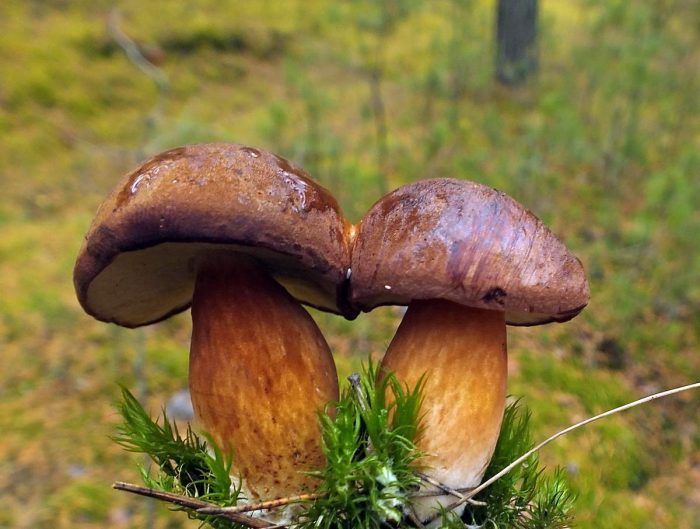
Also known as brown or polish mushroom.
The hat is 4-12 cm in diameter, the shape is semicircular, convex, later becomes cushion and even flat. The skin does not separate, the surface is smooth, dry, becomes sticky in wet weather, matte in young mushrooms, shiny in mature ones. Colored chestnut brown or brown. The pulp is fleshy, dense, whitish or yellowish in color, turns blue on the cut. The aroma is pleasant, mushroom. The leg is 4-12 cm high, 1-4 cm thick, cylindrical, narrowing or widening downward, fibrous structure, light brown, brown or yellow with red-brown fibers.
The mushroom grows next to pines, spruces, beeches, oaks, chestnuts, in conifers, sometimes in deciduous forests, singly or in small groups. The species is distributed in the northern temperate zone of the European part of Russia, in the North Caucasus, in Siberia, in the Far East. The season runs from June to November.
Good quality edible mushroom.Used for freezing, drying and pickling.
Fractured flywheel (Xerocomellus chrysenteron)
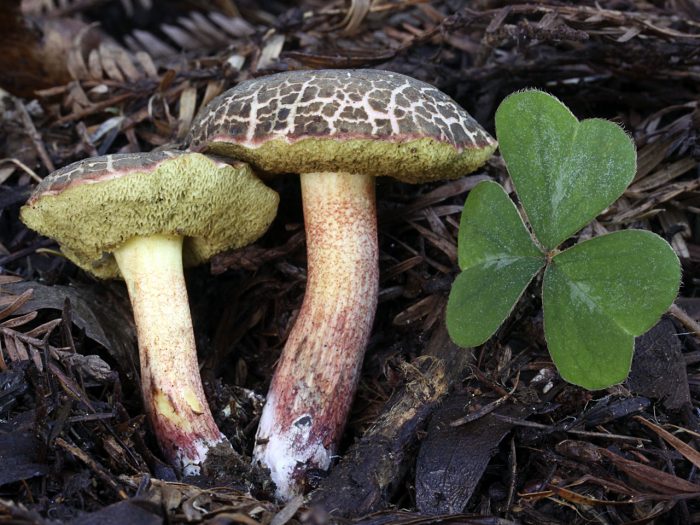
The diameter of the cap is 3-7 cm, the shape is convex or cushion-shaped, less often with a depression in the center, the surface is dry, matte, velvety or bare, burgundy-red, brown, olive-brown, brown, brown-red, ocher-gray. The hat cracks, forming a characteristic mesh. The pulp is white or with a yellow tinge, reddish at the base of the leg and under the cap, turns blue at the cut. Leg 4-10 cm in height and 1-2 cm in thickness, clavate, solid, smooth, fissured surface, light yellow with a red base.
The species is widespread in Europe, the North Caucasus, and the Far East. Grows in deciduous and mixed forests. Fruiting from July to September.
An edible mushroom that is eaten fresh and salted, and is also dried or frozen for use in fried and first courses.
Red flywheel (Xerocomellus rubellus)
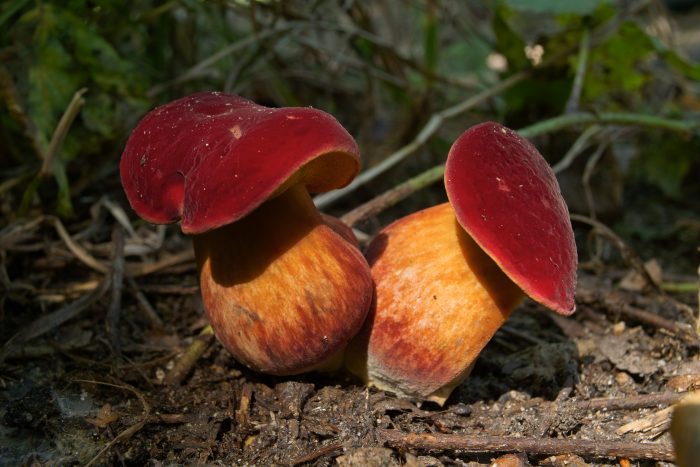
The cap is 2-5 cm in diameter, cushion-convex in shape, flattens with age. Colored bright red. The skin does not separate, the surface is velvety-felt, cracks in mature mushrooms. The leg is cylindrical, tapering towards the base, 3-10 cm in height, about 1 cm in diameter, solid, fibrous, fine-scaled. The color of the stem is yellow with a raspberry-pinkish, reddish or reddish-brown base. The pulp is dense, yellow, turns blue on the cut.
The mushroom grows in deciduous forests, often in oak forests of Europe, North Africa, Asia. The harvest season lasts from August to September. Does not bear fruit abundantly.
An edible mushroom with a pleasant aroma, the taste is not expressed. Used fresh. Darkens on drying.
Green flywheel (Xerocomus subtomentosus)

The diameter of the cap is 3-10 cm, the shape is pillow-convex, the surface is velvety, grayish or olive-brown in color. The pulp is white, turns blue on the cut. The leg is cylindrical, tapers towards the base, 4-10 cm in height, 1-2 cm in thickness, the surface is smooth, the structure is fibrous.
Grows in coniferous and deciduous forests, in clearings, along roads, singly or in groups. It is a cosmopolitan mushroom, as it is distributed on all continents. Fruiting occurs in May-October.
An edible mushroom, used fresh. Darkens on drying.
False flyworms and their photos
Amanita pantherina

Amanita pantherina
With their hats, the mushrooms vaguely resemble the poisonous mushroom Amanita pantherina. It is necessary to carefully consider their reverse side - in the flywheel it is tubular, in the fly agaric it is lamellar, and the outside surface of the cap of the poisonous mushroom is distinguished by small white flakes that easily crumble.
Parasitic flywheel (X. parasiticus)

Parasitic flywheel (X. parasiticus)
It is easy to confuse it with young green mushrooms, if you do not know the conditions for its growth. The parasitic fungus is small in size - a cap up to 5 cm in diameter, lives on the body of a pseudo-raincoat and is extremely rare. In addition, it lacks a characteristic blue discoloration on the cut and an expressionless smell and taste. Although it is considered non-poisonous, no mushroom picker will put it in a basket.
Pepper Mushroom (Chalciporus piperatus)

Pepper Mushroom (Chalciporus piperatus)
A poisonous pepper mushroom (Chalciporus piperatus) looks like a red flywheel, which has a cherry-reddish tint of the leg and tubular layer. On the cut, both the cap and the leg turn pink, in contrast to the moss blue.
Gall mushroom (Tylopilus felleus)

They are more often confused with young boletus and boletus mushrooms than with mushrooms, but there is still a chance of getting into the company of mushrooms. Although the gall mushroom is not poisonous, its bitter taste, which appears during heat treatment, will spoil any mushroom dish.
Chestnut Mushroom (Gyroporus castaneus)

Chestnut Mushroom (Gyroporus castaneus)
The variegated flywheel also has an inedible double - a chestnut mushroom, or chestnut gyroporus (Gyroporus castaneus) with the same brownish cap, which changes shades during maturation and becomes covered with a fine mesh of cracks in dry weather. It is distinguished by a hollow brownish leg, does not change color on the cut, which cannot be said about its relative, the blue gyroporus (G. cyanescens), less like a flywheel due to its grayish-brown or brownish-yellow cap. Both mushrooms are inedible and taste very bitter in dishes.
Cooking recipes
It is not difficult to cook fissured flywheel, but it is not very popular, because it has a slimy structure in dishes. The most suitable for food are young mushrooms, which can be salted, dried, fried and frozen. They are also used for making soups and stewing, they are good mixed with others.
Primary processing
The main processing of moss flies is to clean them from forest debris, earth and wormholes. It is better to throw away rotten specimens. Next, you should clean it, remove the hard legs from old fruits, then rinse under running water. You can combine these two processes by flooding the mushrooms with water, then gradually clean them.
Cooking
Boil the fissured flywheel in salted water for 30 minutes, then take out the mushrooms, allow the liquid to drain. Now they can be used further or frozen in the chamber for the winter. Salt water during boiling should be to taste.
Pickling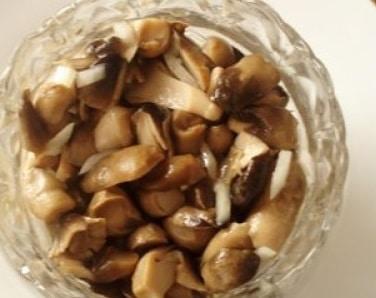
To pickle pasture boletus, you need to take:
- mushrooms - 2 kg;
- salt - 2 tbsp. l .;
- sugar - 1 tbsp. l .;
- vinegar - 3 tbsp. l .;
- garlic - 3 cloves;
- laurel - 3 leaves;
- carnation - 3 buds;
- horseradish and currant leaves - 2 pcs.
The mushrooms are pre-boiled, and at this time the marinade should be prepared:
- Put salt, sugar in a liter of water and bring to a boil.
- Add bay leaves and cloves.
- After a couple of minutes, pour in the vinegar.
- After another minute, add the boiled mushrooms.
- Boil for 15 minutes.
- Now you need to put a sheet of horseradish and currants in each jar, put boiled mushrooms on top and a chive of garlic, pour marinade to the top.
- Close with plastic lids and store on the bottom shelf in the refrigerator.
Freezing
In order to keep the mushrooms in their best shape, and then use them in any dish in winter, they should be frozen. To do this, peeled and boiled cracked mushrooms need to be cooled and laid out in prepared containers or bags. It is most convenient to make portioned blanks, then it will be easy to get the fruits.
Frying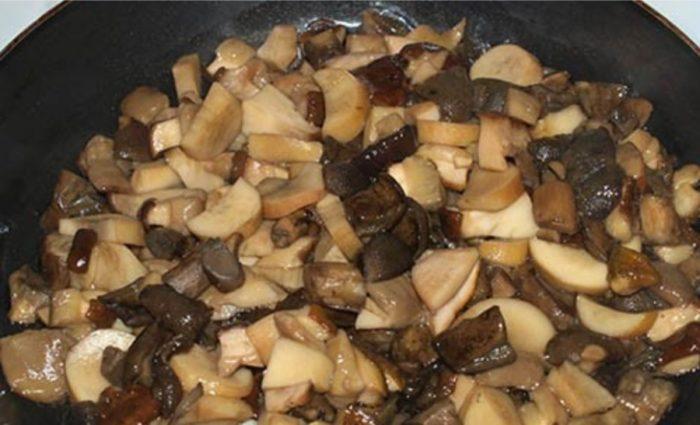
In order to pamper yourself with an unusual and tasty dish, it is best to fry the flywheat and serve with buckwheat. For cooking you will need to take:
- boletus pasture - 1 kg;
- vegetable oil - 3 tbsp. l .;
- onions - 150 g;
- salt and pepper to taste.
Cooking process:
- Pour oil into a frying pan and heat over a fire.
- Add the mushrooms and fry until golden brown.
- Then add the finely chopped onion. It is necessary to remove the dish from the heat when the onion acquires transparency.
Salting
In order to taste the salty cracked flywheel, you need to prepare:
- boiled mushrooms - 1 kg;
- salt - 100 g;
- allspice peas - 6 pcs.;
- laurel - 3 pcs.
The preparation is as follows:
- Flywheels are placed in an enameled dish in layers, sprinkling with salt each time.
- Bay leaf and pepper should also be placed in between the mushrooms.
- Sprinkle the top with salt and cover with a cloth, install the load.
- After a few days, the mushrooms will be covered with brine.
- After a month, ready-made fruits can be tasted.
Mushrooms are salted in a cool, dark place. After they are cooked, further storage takes place in the refrigerator.
Drying
Pestles do not need to be boiled or washed to dry. It is enough just to clean, leave only good whole copies and string them on a thread. Flywheels are hung out on the sunny side in a well-ventilated place.
In order for everything to work out as quickly as possible, it is better to dry the mushrooms in medium-sized pieces, and cut them into equal pieces - this way the drying process occurs more evenly. Store dry forest fruits in a closed container, away from strong odors.
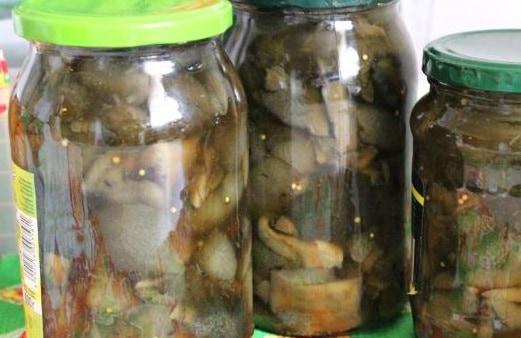 Canning for the winter
Canning for the winter
In order to prepare mushrooms for the winter, it is enough to marinate them according to the above recipe and sterilize them, then seal them with metal lids and store them in the basement. The mushrooms should be sterilized for at least 30 minutes. All dishes and lids must first be cleaned and heated in boiling water.
Borovik as a genus
As mentioned above, boletus is a genus, it includes more than 300 species. This genus is the most popular and noble white mushroom. People call it boletus, because of this, many mushroom pickers get confused. This genus includes other species that bear the name of the genus, for example, the boletus royal. In this case, there is a difference between the royal boletus and the porcini mushroom.
Did you know? The white mushroom can adapt to any conditions, this is proved by the study of the destroyed nuclear reactor in Chernobyl, where these mushrooms were found. They evolved in the usual way, despite the radiation.
In fact, all specimens of this genus can easily be called boletus. As a rule, they can be found in deciduous, coniferous and oak forests, mainly under trees, since the connection with their roots is necessary for the development of fungi. Boletus almost always have a large body, which consists of a cap and a wide leg. The hat is shaped like a pillow. It can be velvety or smooth. There are small scales on the stem. The flesh is mostly white or light yellow. Spores are yellow, red, but also white.
Boletus grows mainly from May to November. It all depends on the climate, during this period you can easily collect a basket of not only porcini mushrooms, but also other species. The best time for harvesting is considered to be the earing period of cereals.
Motley (fissured) and velvet flywheels
The variegated flywheel, or fissured flywheel, is an edible tubular mushroom that grows singly or in small groups from early July to early October. The largest harvest is in August. Found in mixed, deciduous, sometimes coniferous forests.
A mushroom cap with a diameter of about 8-10 cm. The surface is dry, matte, small cracks form an openwork pattern on it. It is colored red or brown with a burgundy or olive tint, with a darker and more saturated color in the middle. In this species of flyworms, the tubular layer is large-pored, adherent, greenish-yellow in color. The stem is rounded, thinner at the base, straight or curved, solid inside, about 5–7 cm high and about 1 cm in diameter. Its surface is flat, dry, dull, yellowish-red.
The flesh in the cap is first fleshy, soft, then loose, stiff in the stem, fibrous, with a pleasant mushroom aroma and taste. Upon contact with air, its yellowish color quickly changes to blue.
The variegated flywheel belongs to the third category of mushrooms. Only the caps of young mushrooms are used for food, which are universal in their culinary qualities and are suitable for preparing a variety of dishes and snacks.
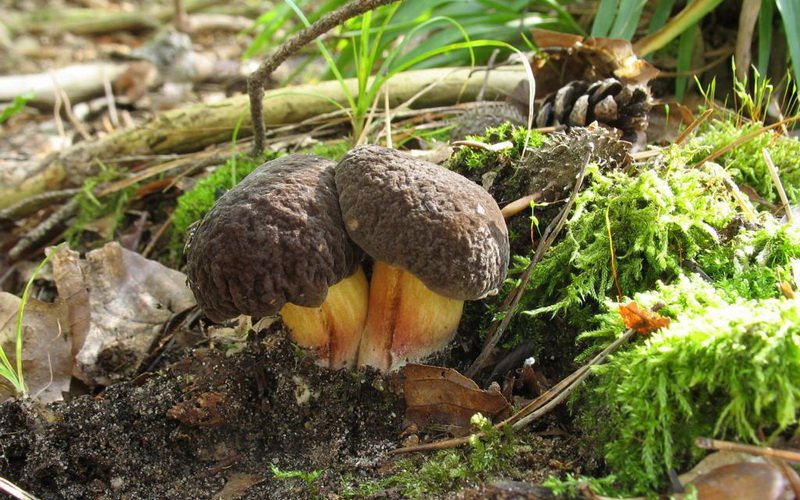
Velvet moss wheel in the photo
Velvet moss (Boletus prunatus) has a hemispherical cap with a diameter of 4-12 cm, sometimes up to 15 cm. A distinctive feature of the species is a dry matte, velvety-brown cap with lighter edges. The skin on the cap is dry, fine-grained and almost felt, becomes smoother over time, a little slippery after rain.
The leg is cylindrical, 410 cm high, 6-20 mm thick. The stem is usually lighter in color than the cap, often curved, creamy yellow and reddish in color.
Pay attention to the photo - this edible flywheel has a dense, whitish flesh with a yellowish tinge, when pressed slightly turns blue, has a weak mushroom taste and smell:
The tubules in youth are creamy yellowish, later yellow-green. Spores are yellowish.
Variability: The cap becomes dry and velvety over time, and the cap color changes from brown to reddish brown to brownish brown. The color of the stem varies from light brown and yellow-brown to reddish-brown.
There are no poisonous counterparts. According to the description, this mushroom is a flywheel similar to a variegated flywheel. The main difference is that Boletus chtysenteron has cracks on the cap.
Habitat: grows in deciduous, coniferous forests.
Cooking methods: drying, pickling, boiling.
Season: June - October.
Edible: 3rd category.
Next, you will find out what other types of moss mushrooms are.
The healing properties of porcini mushrooms
The healing properties of porcini mushrooms are beyond doubt: polysaccharides have been found that have the ability, like lentinan from shiitake, to suppress tumor cells. Experiments have shown that porcini mushrooms have antitumor properties (100% against sarcoma strain, 80 and 90% against carcinoma strain) (Lucas et al. 1957; Ying et al. 1987). In addition, boletus polysaccharides inhibit microbial infection and have natural antibiotic properties. Polysaccharides A (glucan) and B (glucogalactomannan) change the blood formula, contribute to an increase in the number of neutrophils in the peripheral blood (Grtsibek et al., 1992), that is, they contribute to the normalization of the blood formula (increase the hemoglobin level, normalize platelet production), and the unique composition of amino acids (8 essential amino acids) improves health and strengthens the immune system (Ying, 1987). In the latest developments of Russian scientists, the ability of the melanin pigment found in porcini mushrooms has been discovered to integrate into the protein structure of the cell and force it to divide more actively, that is, this substance makes cells (for example, the epidermis) regenerate faster. It is no coincidence that our ancestors applied fresh porcini mushrooms or powder from them to non-healing wounds and burns. The Boletus preparation is a porcini mushroom extract obtained using a complex freeze-drying technology (that is, high and ultra-low temperatures that “break” the structure of the polysaccharide are not used in its production). The gentle technology developed specifically for the production of medicinal mushroom preparations is used only by our company. Therefore, our mushroom preparations are so effective, have no analogues either in Russia or abroad and are in great demand.
Application of porcini mushroom (Boletus):
- tuberculosis;
- malignant and benign neoplasms;
- improving metabolism;
- diseases of the gastrointestinal tract.
Primary processing and preparation
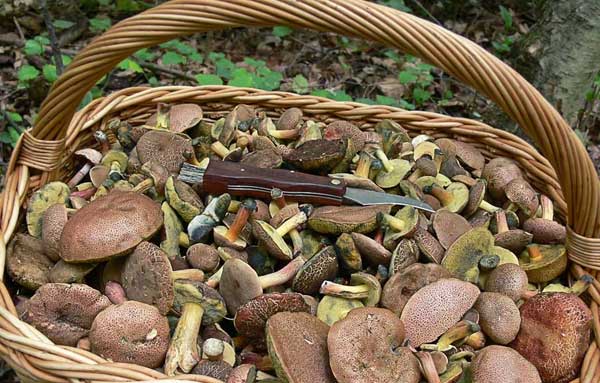
All edible members of the genus have a fleshy, nutritious pulp. After you get home, immediately start processing the flywheels. Rinse off forest debris. Then inspect the fruit body, if you find passages from worms, cut off the damaged areas.
Soups are made from them, they are fried, stewed, baked. You can also eat hats and legs, and it is better to remove the skin from the hats. Young mushrooms are more suitable for cooking, since old ones are often wormy. You can fry without prior boiling.
For long-term storage, they are salted, pickled and dried.
Useful properties and contraindications
In their composition, mushrooms contain many healthy substances: enzymes that facilitate the digestion of food; natural sugars, thanks to which dishes made from them are considered low-calorie and suitable for dietary nutrition; vitamins PP, D and B; microelements, including molybdenum and calcium, according to the content of which, mushrooms occupy a leading position among mushrooms.
Mushrooms do not produce harmful effects on the body. Most mushrooms are perceived by the stomach as a heavy food, therefore people with chronic liver and gastrointestinal tract diseases are advised to refrain from eating mushroom dishes in large quantities. However, mushrooms do not create such a pronounced effect of gravity on the stomach as other mushrooms. Still, you should not offer them to children under 3 years old and, of course, those who are allergic to mushrooms.
Types of moss
In the genus Mokhovik (Xerocomus), there are 18 species, of which only seven are found in the vastness of Russia.
Polish mushroom (X. badius)

Photo of Polish mushroom
Reputed to be an excellent edible mushroom, one of the most delicious in Europe. It has a rather large size: the brownish cap sometimes reaches 12–15 cm in circumference, and the leg rises by 10–13 cm. Its flesh is fleshy, with a pleasant taste and a pronounced mushroom odor, whitish or slightly creamy yellow.Tubular layer of golden, later - olive-yellowish color, light brown spores. In Russia, it grows more often in coniferous forests on sandy soils, it is found in the European part, in the North Caucasus, in Siberia and on the island of Kunashir.
For more information, see the article "Polish mushrooms."
Good edible mushrooms are: red flywheel, green flywheel and motley or fissured flywheel.
Red flywheel (X. rubellus)

Photo of a red flywheel
A medium-sized mushroom with a rich red cap up to 8 cm in circumference, velvety-felt to the touch. It rises on a thin, up to 1 cm thick, stalk about 10 cm high, at the base with a pinkish salmon tint. The tubular layer is dull yellow, the spores are brick-brown. The species is collected only in deciduous forests, more often in the oak forests of Europe, the Far East, the mushroom is found in North Africa, but it is not called ubiquitous growing.
Green flywheel (X. subtomentosus)

Photo of a green flywheel
A mushroom with an olive-brown or grayish cap up to 10 cm in diameter and a cylindrical, slightly narrowed downwards, smooth stem up to 2 cm thick and 4 to 10 cm high, white flesh and yellowish hymenophore. It grows everywhere, both in deciduous and coniferous forests, it is found even on anthills. The area of distribution is extensive.
Flywheel variegated or fractured (X. chrysenteron)

Motley or fractured flywheel
A mushroom with a characteristic network of cracks on a small (3–7 cm in diameter) cap, which differs in different shades: burgundy-cherry, olive-chocolate, terracotta-red, ocher-gray. An unusual clavate shape is observed at a leg that grows up to 10 cm. Below, the leg is reddish with barely noticeable grayish-fibrous belts. The hymenophore is large-pored, creamy yellow or light olive in color, the spores are yellow-brown. Distributed everywhere: in coniferous and mixed forests on loose sour soil throughout Europe and the European part of Russia, in the Far East and the North Caucasus.
The conditionally edible species include the following types of moss:
- blunt (X. truncatus),
- chestnut (X. spadiceus),
- powdered (X. pulverulentus),
- woody (X. lignicola),
- semi-golden (X. hemichrysus).
The parasitic flywheels (X. parasiticus) and asteraceae (X. astraeicolus) were identified as inedible non-toxic fungi.
The appearance of the mushroom
The satanic mushroom looks similar to boletus. A large-sized cap reaches 30 cm in diameter, in young specimens - 7 cm. The color of the cap is gray-white with a yellow or green tint. The skin is smooth, pleasant velvety, dry.
The leg is large, reaching a height of 6-18 cm. The palette is presented from gray to brown-pink, almost red. It resembles a turnip in shape. The leg is covered with a coarse-mesh pattern. It is dense in structure, widened downwards, tapers upwards. The satanic mushroom has a tubular hymenophore.
The difference between young and old specimens is the smell. The young have a pronounced pleasant, mushroom, old mushrooms smell like rotten vegetables.
The Satanic mushroom resembles the traditional white mushroom, which is why they are often confused. It is poisonous, provokes gastrointestinal upset. Toxins do not lose their qualities even after processing and prolonged cooking.
Spreading
The ecology and range of representatives of the same genus are similar, but still slightly differ from species to species.
- Green moss grows in coniferous and deciduous forests, as well as along the edges of ditches and roads. Forms mycorrhiza with a wide variety of trees (deciduous and coniferous). Distributed throughout Russia, growing from June to October.
- The variegated moss grows in mixed and deciduous forests, as well as along roadsides and ditch edges. It is quite rare, listed in the red books of some regions of Russia. Forms mycorrhiza mainly with beech, less often with other broadleaf. Occurs from July to October.
- Red flywheels usually grow in herbaceous communities (for example, at the edges of deciduous forests). They prefer oak groves. Distributed in the northern part of the temperate zone. They grow from August to September, and are quite rare.
Cooking recipes

Moss salad
After a “quiet hunt”, a novice mushroom picker has a “problem”: how to cook mushrooms appetizingly, despite their mediocre taste declared in all culinary guides?
The main thing is to remember an important thing - from interaction with air, the mushrooms immediately begin to darken, so fresh peeled mushrooms are immediately immersed in water, adding 2 g of citric acid and a teaspoon of salt to 1 liter. In salted and pickled form, mushrooms are excellent preparations for the winter, but they rarely go for drying - due to the same characteristic darkening
Both hats and legs are used to prepare dishes from moss mills. It is not necessary to pre-boil the flywheels before frying or adding to soups, and the Polish mushroom is eaten raw as the main focus of salads. The "Funky" salad is incredibly tasty, although pickled mushrooms are taken for it all the same
In salted and pickled form, mushrooms are excellent preparations for the winter, but they rarely go for drying - because of the same characteristic darkening. Both hats and legs are used to prepare dishes from moss mills. It is not necessary to pre-boil the flywheels before frying or adding to soups, and the Polish mushroom is eaten raw as the main focus of salads. The "Funky" salad is incredibly tasty, although pickled mushrooms are taken for it.
Polish mushroom salad
- mushrooms - 0.5 l jar,
- processed cheese - 100 g,
- boiled potatoes - 5-6 pieces,
- pickled cucumber - 2-3 pieces,
- mayonnaise for dressing,
- greens to taste.
Experienced cooks advise using cucumbers for this salad from a citric acid marinade, and not vinegar. All components of the dish are crushed, mixed and seasoned with mayonnaise, herbs are added at will.
Flywheels for this salad, and for many other dishes, are prepared for the winter as follows:
Pickled flywheels
The mushrooms are cleaned and washed thoroughly, the damaged and too large ones are sorted out, leaving no more than 5-6 cm in circumference with the caps.
Put in a saucepan, pour over water and bring to a boil, then boil for 10-15 minutes over low heat and pour the contents into a colander. Allow the water to drain, and at this time prepare the marinade. 1 tablespoon of salt and sugar is poured onto 1 liter of water, 2 small bay leaves, a few cloves of garlic and just a little cloves are added. After boiling, pour 1 tbsp. a spoonful of vinegar and put mushrooms in a saucepan. Boil in the marinade for 5 minutes, then put it in sterilized glass containers so that the liquid covers all the contents, and roll up.
Soups and stewed or fried side dishes are obtained from mushrooms, and baked in sour cream they can well claim to be an exquisite culinary masterpiece.
| Name: | Chestnut mosswheel |
| Latin name: | Boletus ferrugineus |
| Type of: | Edible |
| Synonyms: | Brown flywheel, Dark brown flywheel, Boletus spadiceus, Xerocomus ferrugineus, Xerocomus spadiceus |
| Specifications: | |
Systematics:
|
Chestnut moss is a representative of the Boletov family, the Moss family. It got its name from the fact that it grows mainly in moss. It is also called the brown or dark brown moss and the Polish mushroom.
Description of appearance
It is an edible, rather tasty mushroom with a massive fruiting body. It grows mainly in mosses, which is why it got its name.
Hat
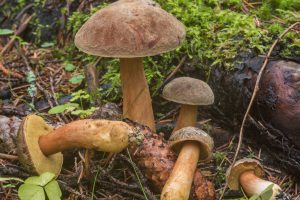 In young representatives, the caps are initially dense, closed, and have a hemispherical shape. Then they begin to open and, as a result, reach up to 10 cm in diameter. Colored in brown, olive, yellowish-brown tones.A rather dense tubular layer is located under the cap, which forms large pores.
In young representatives, the caps are initially dense, closed, and have a hemispherical shape. Then they begin to open and, as a result, reach up to 10 cm in diameter. Colored in brown, olive, yellowish-brown tones.A rather dense tubular layer is located under the cap, which forms large pores.
The pulp is dense, juicy, has light shades on the cut that do not change even over time. Moreover, the younger the mushroom, the firmer its pulp. If the flywheel is ripe, its consistency becomes soft, elastic: when pressed, it easily restores its shape, like a sponge. Has a mild mushroom aroma.
Leg
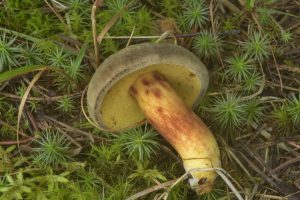 It grows up to 12 cm in height, while it is massive - up to 4 cm in diameter. It is cylindrical in shape, it can both expand and narrow towards the bottom. Consists of numerous fibers, which are coarser in consistency than the cap. The leg is painted in brown, yellow or brown shades.
It grows up to 12 cm in height, while it is massive - up to 4 cm in diameter. It is cylindrical in shape, it can both expand and narrow towards the bottom. Consists of numerous fibers, which are coarser in consistency than the cap. The leg is painted in brown, yellow or brown shades.
Edible flywheel
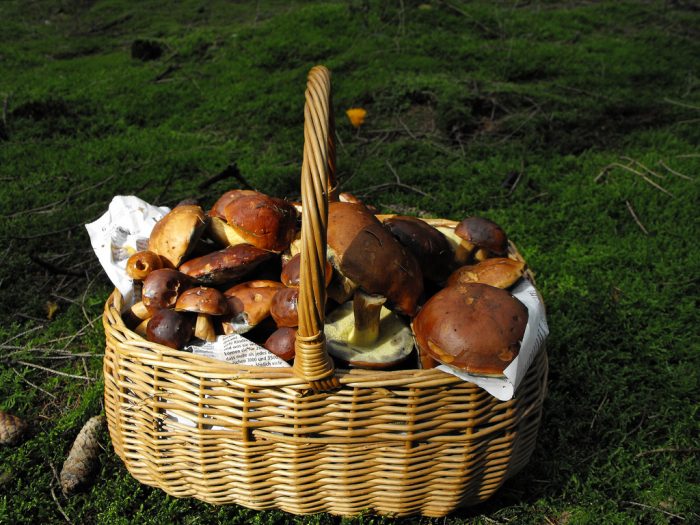
Among the mushrooms there are both edible and inedible ones. Edible species are used for food without preliminary boiling for first courses, salting, pickling and drying. In cooking, the whole mushroom is used: both the cap and the leg. The skin is removed from the cap, and the leg is peeled. To improve the assimilation of mushrooms, they are thoroughly crushed. Dried mushrooms acquire a beautiful golden hue and pleasant smell.
Flywheels are rich in easily digestible proteins, sugars, enzymes and essential oils, they also contain vitamins A, B, B2, C, D and PP.
In addition, flywheels contain specific substances that quickly darken in air and spoil the appearance of the mushroom. Therefore, before cooking, the mushrooms need to be processed quickly so that they do not stay in the air for a long time in a purified form, they are immediately placed in water. When boiling, a teaspoon of salt and half a teaspoon of citric acid are added per liter of water.



